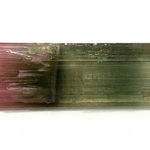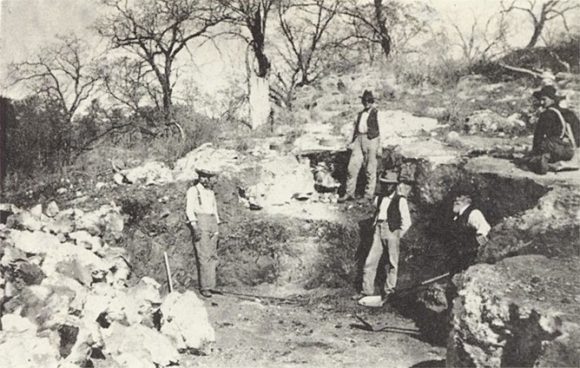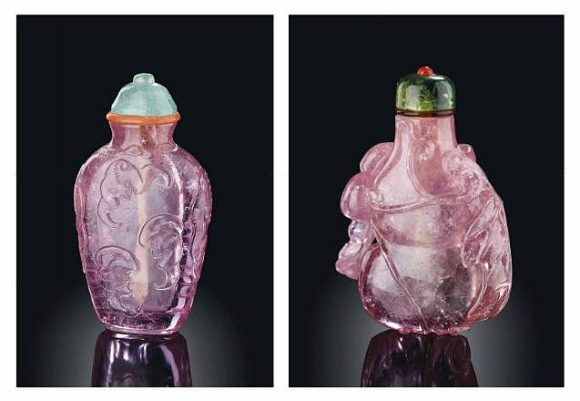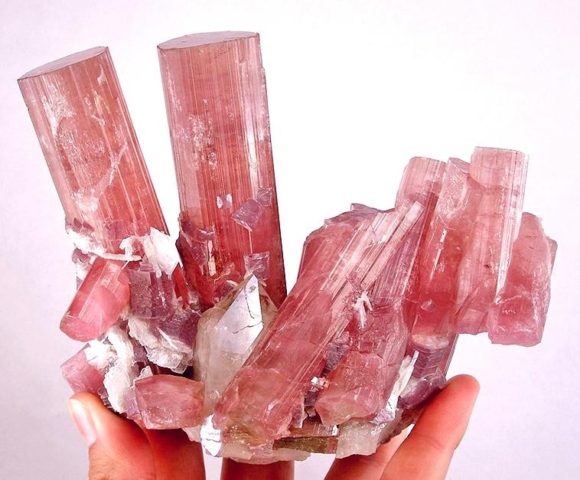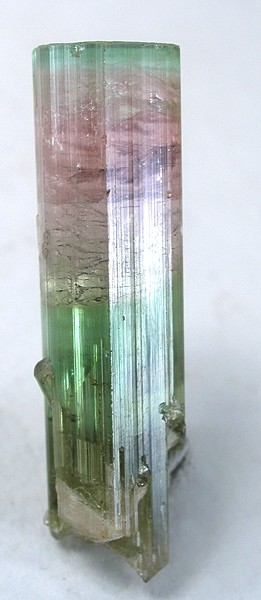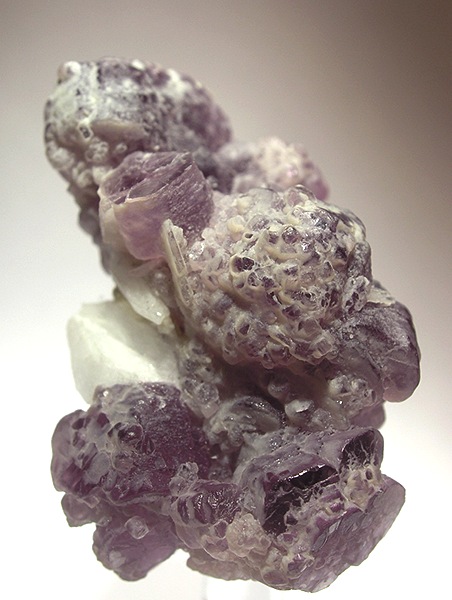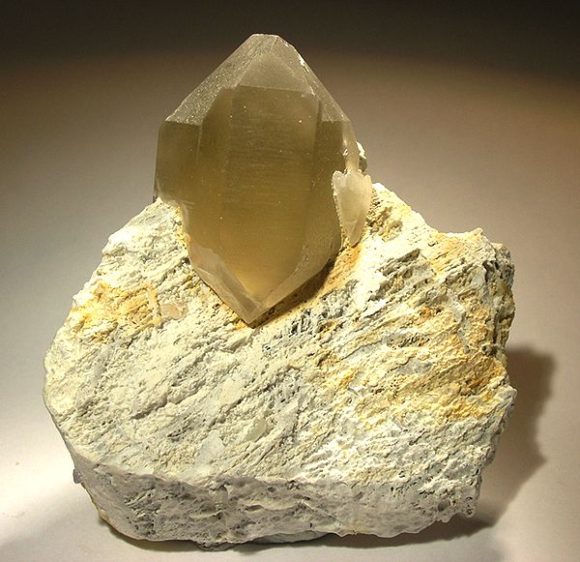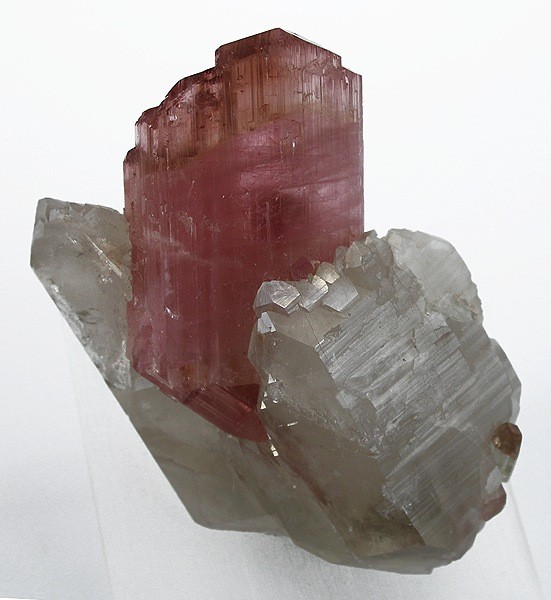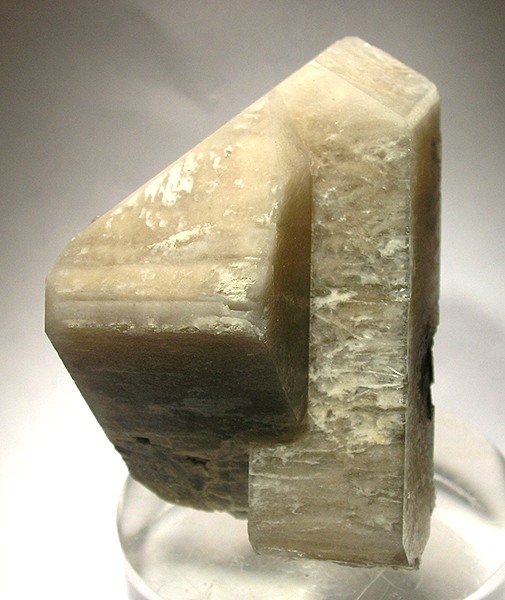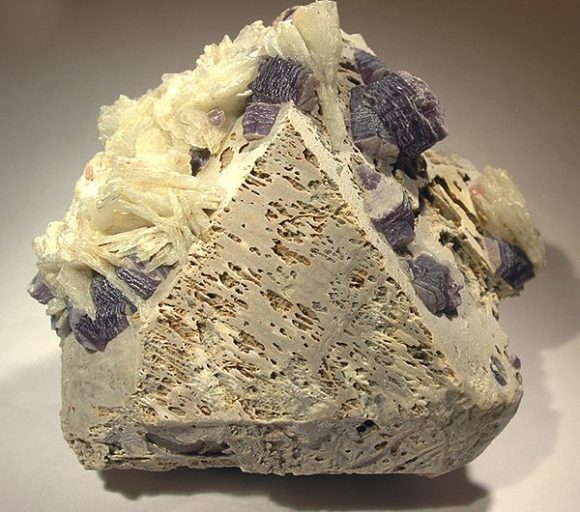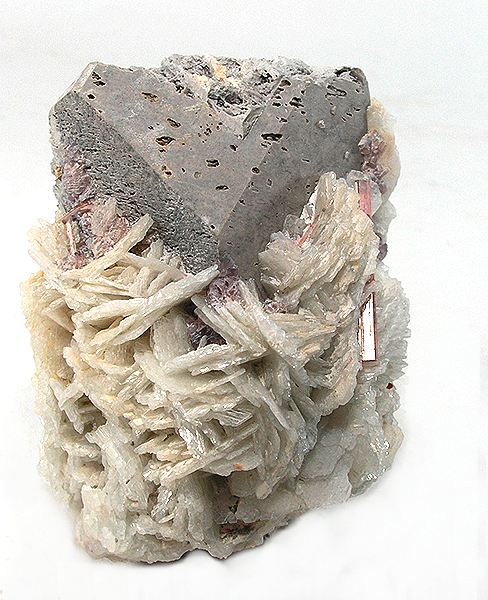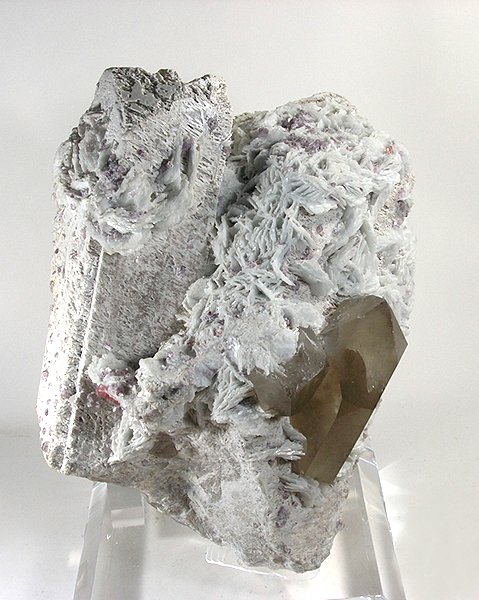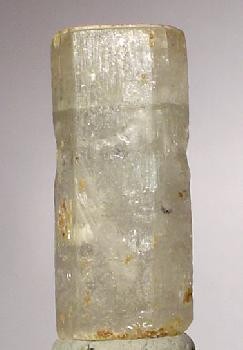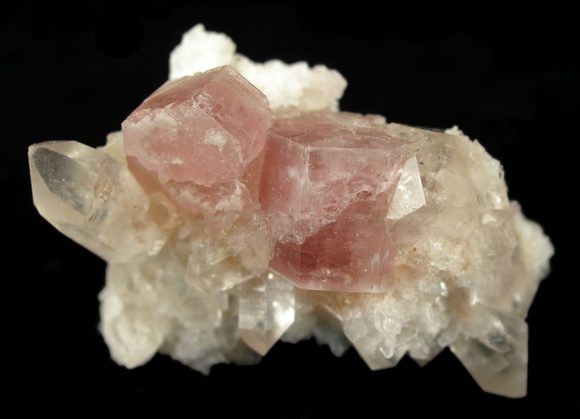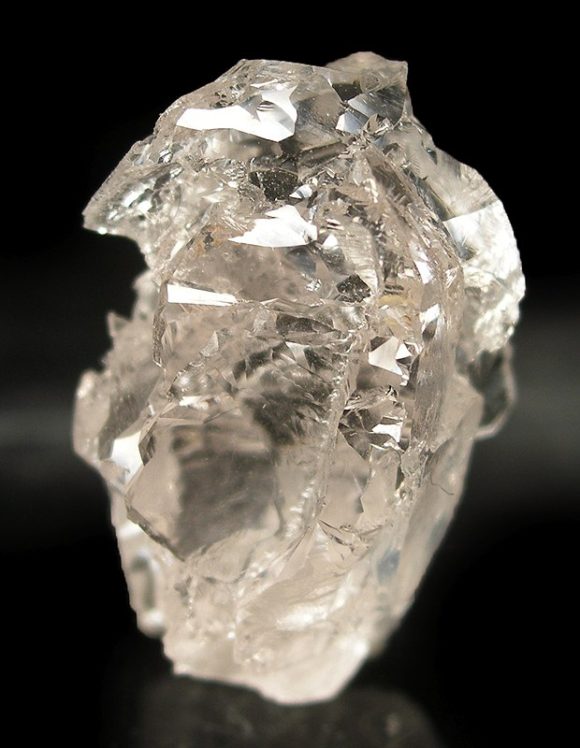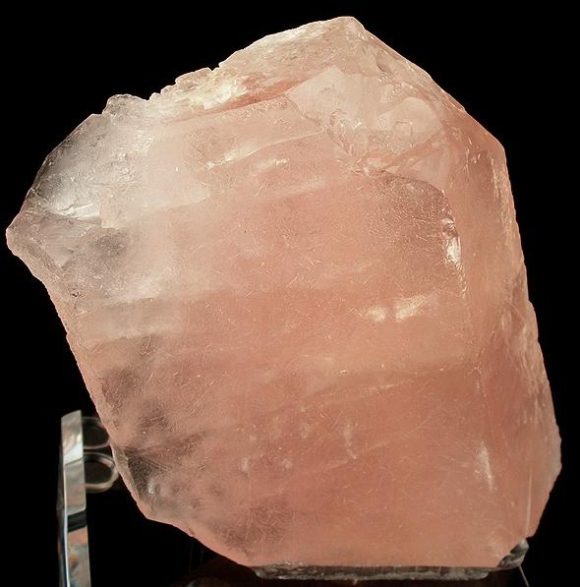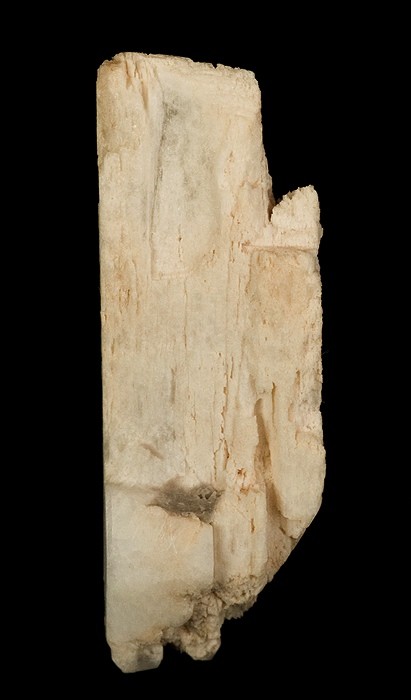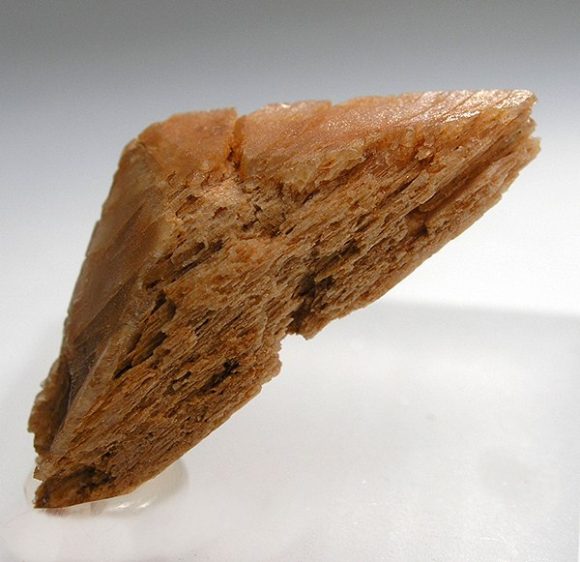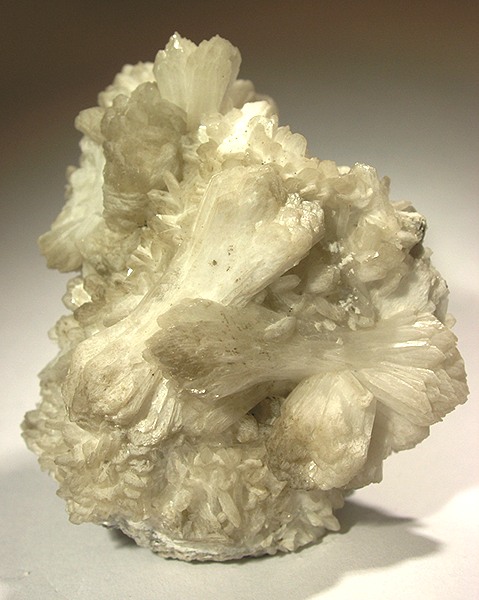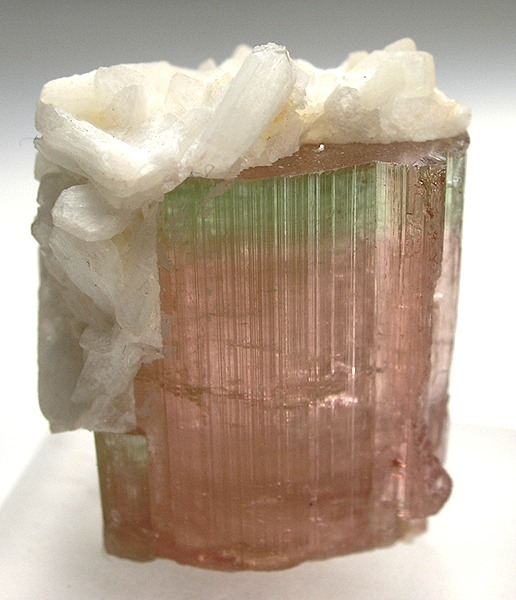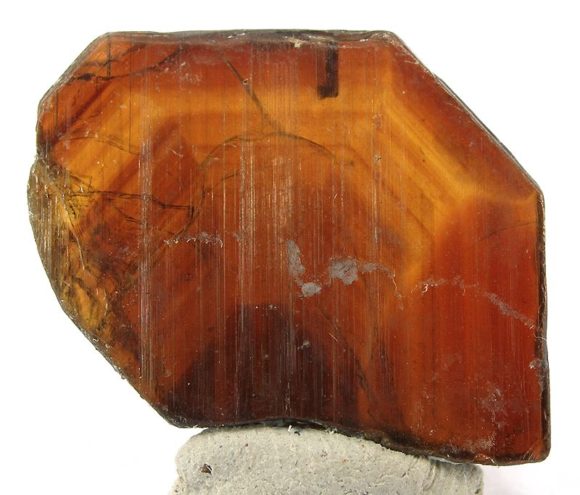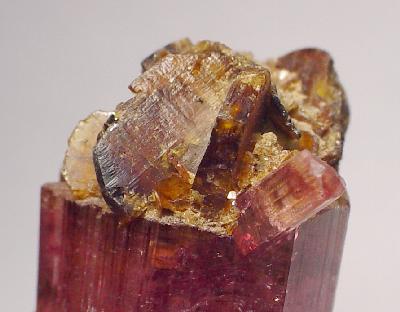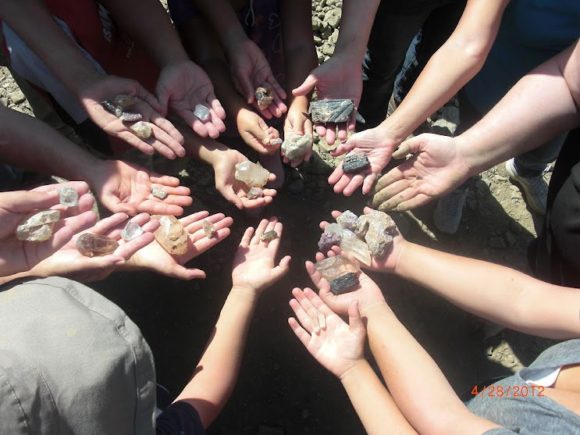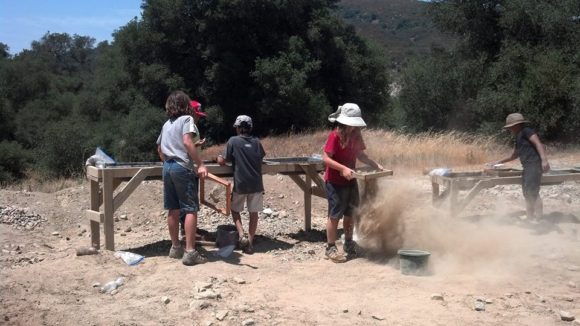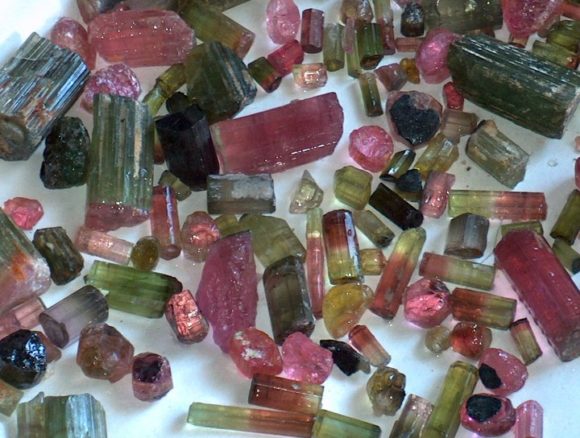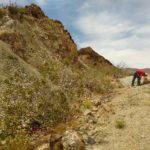
Written by Justin Zzyzx – Author of “Rockhound Barstow”
This location and many others are featured in the field guide – Click here to buy a copy for yourself
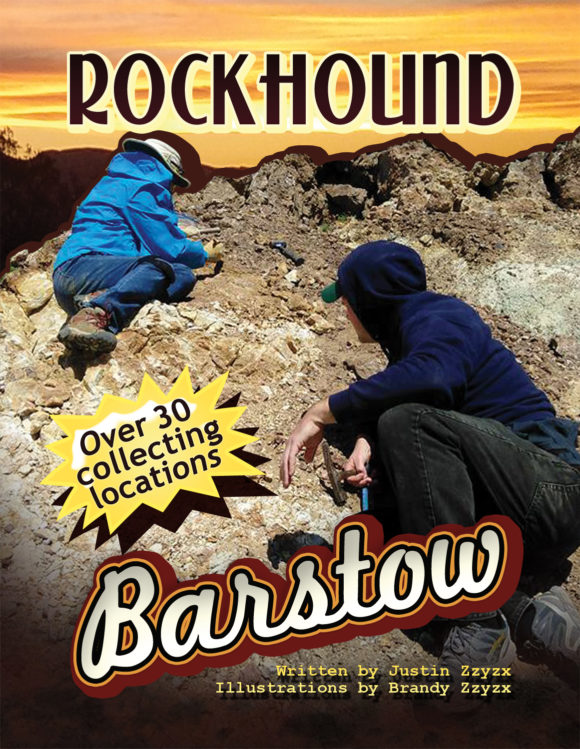
Click the Cover and Order your copy today!
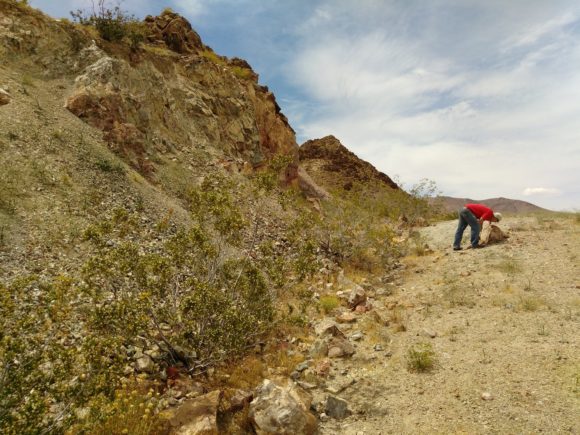
Justin Zzyzx inspecting boulders at the Noble Prospect.
I just love exploring the nooks and crannies of the hills and mountains around Barstow California. The area around here is known for the beautiful geological formations all around, such as Rainbow Ridge, as well as the silver mines of Calico, once a silver boom town, now a commercial tourist attraction. Barstow, a perfect place to set up base and explore the Cady Mountains, Afton Canyon, Opal Mountain, Mule Canyon, Alvord Mountain, Yermo’s rolling hills of alluvial agates and jaspers and so much more. There is a veritable treasure chest of mineral adventures to be had in these colorful hills, visiting is a thrill, and I, as a resident, love to take full advantages of these rock deposits.
As a frequent leader of field trips and author of the “Rockhound Barstow” field guide, I’m always looking for new places to take people to collect interesting minerals and lapidary materials. My personal favorite is finding places where there are both nice crystallized minerals, as well as colorful lapidary material, that way, out of the dozens of rockhounds who have joined me over the past year on each monthly field trip, everybody is happy with what they can find. Exploring mining information on MRDS.org, I noticed several mines located in the Northern parts of the Calico mountains. I could see, just 10 miles away from my pistachio grove I call home in Newberry Springs, there was a Wollastonite mine, a Nickel mine and an Arsenic mine, all bunched up to the West of Coyote Dry Lake.
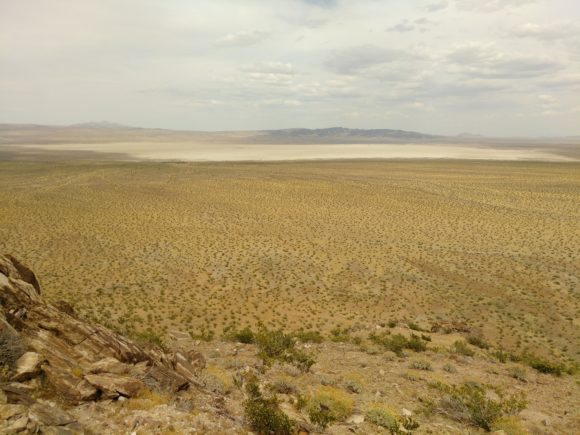
View looking out to Coyote Dry Lake from the un-named Nickel deposit
On our first outing to this string of locations we tried to access it from the East, coming up Coyote Dry Lake road. The dry lake was not as dry as we expected, in fact, it was quite moist and with no desire to go “muddin”, we turned back and tried the other way into the area, all the way around the Fort Irwin road passage, 20 miles to the West. Fort Irwin road is a VERY busy two-three lane road that connects Fort Irwin to Barstow and highway 15. Fort Irwin, a large Marine base, requires a large amount of workers from the Barstow area to work the service industry jobs, as well as the tech jobs, along with all the contractors, you can imagine this is a very busy road. We drove through the pass on the West side, looking at all the remains from the silver mines that made the Calico district what it was and what it is today. The ore was mostly chloragyrite, a silver mineral that is toxic to process, proving to be costly and environmentally unsound, so, the silver mines stand dormant, forever.
Entering on Madrugador road, Eastbound from Fort Irwin road, you pass by a Wollastonite deposit to the North, which we inspected with little of interest to be found, then, continuing along on this fairly smooth, slightly rocky road we turned off to the Northeast on a power line road which then takes us directly to the Wolly Wollastonite #5 deposit, a long abandoned deposit of this interesting white mineral. Some field guides have published this location, however, they always refer to it as an Onyx deposit. Onyx, a name for Calcite, is found at lots of places around the Calico mountains, however, at this deposit, there is only the non-stop white bliss of massive Wollastonite.
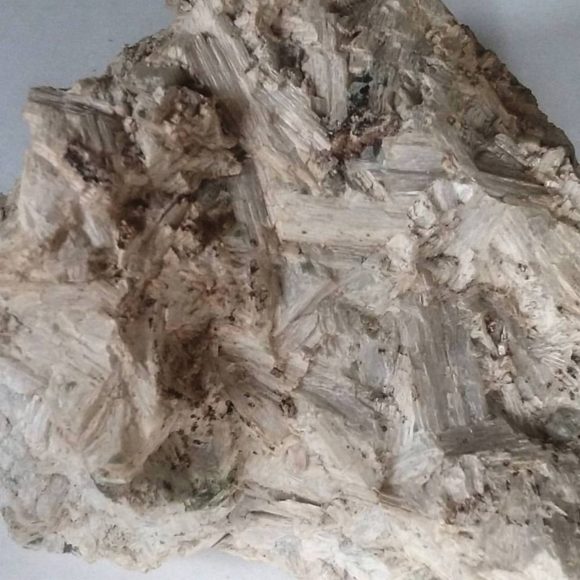
Long fiber Wollastonite crystals on the surface of massive Wollastonite
Wollastonite is a mineral that can be found as part of a Skarn deposit. Common related minerals are Grossular Garnet, Calcite, Quartz, Hedenburgite, and Epidote. The grains of the skarn deposits can be quite dense, leading to amazingly hard stones that can be worked into lapidary objects like vases and pillars. The wollastonite here was most likely mined for use in the pottery industry. Wollastonite, CaSiO3, a Calcium Silica Oxygen mineral that often has impurities of iron, manganese and magnesium, all elements found in abundance across this mountain range. Crushed, this powdered rock would be used for adding to clay, reducing cracking when ceramics are fired in a kiln, as well as added to paint base, a filler to make paint thicker.
At the Wolly Wollastonite deposit we would find tons of massive white wollastonite with the choice mineral specimens being the small bits and thin plates of acicular “long fiber” wollastonite crystals, which form flat on the surface of the rocks and boulders. Along with these, a bit of orange Grossular garnet can be found forming in the sharp borders between the wollastonite and the county rock. Finding larger pieces of this material is uncommon, but possible, however bits of wollastonite with thin areas of garnet are fairly common along the waste rock piles. In the quarried areas, along the rock wall, you can see several veins of garnet, but, in my opinion, they are not terribly thrilling. One thing is for sure, the guides that have continuously pegged this as an Onyx deposit can now be corrected in the next printing! The deposit takes up the Northern side of this far outlying mountain, spilling out of the most Northern part of the Calico mountains. Various bits and smears of other minerals have been spotted, like epidote and hedenburgite, so with further exploration you might uncover something interesting.
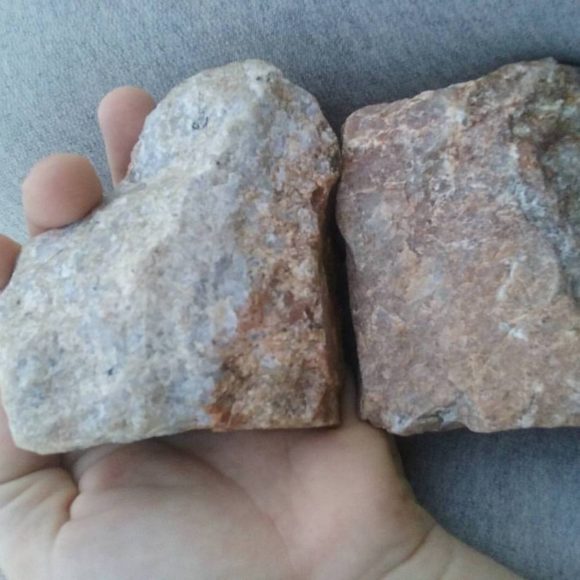
Spessartine garnet masses found in conjunction with the wollastonite deposits of the North Calico Mountains
A few months before I decided to visit this Wollastonite deposit, I was told by a gold miner in the Hesperia area that there was a Wollastonite deposit up in the North Calico mountains that had terminated grossular garnets. Wollastonite forms as a part of skarn deposits. One of the best mineral deposits in these formations are calcite pods with glossy grossular garnets underneath. Locations around the world produce specimens like this, the calcite acts as a blanket for the garnets, protecting them from any harm, until we, rockhounds, remove them from the ground and soak them in acid to dissolve the calcite and reveal the beautiful garnets underneath. While massive garnet is found at the Wolly Wollastonite deposit, the lack of calcite pods at this and every other Wollastonite deposit I’ve visited has turned up fruitless. Yet, chasing this lead has brought me to explore some infrequently visited areas of the rocky desert hillsides.
Going back in reverse from the Wollastonite deposit, you can head South in the first turn, which is a wash that leads up to the solid hillside and upwards on a road that leads to a former Nickel deposit, resting on this craggy spire, a semi steep climb leads to a non-connecting circular road around the peak. From here you have spectacular views of the valley below, the vast white/tan of Coyote Dry Lake, the Coptic monistary, and hey, I can even see my house from up here! Looking at this location from the comfort of my home, with my imported mine marker data from MRDS, I could see this Nickel mine and also find out more information about it. It referenced a mention in a a Southern Pacific Railroad booklet on Mineral of Industry, Volume 3, which mentions the deposit geology as “niccolite, arsenopyrite, annabergite, and uvarovite in a verticle silicic dike that strikes NE along a shear zone in hornfels and quartzite.”
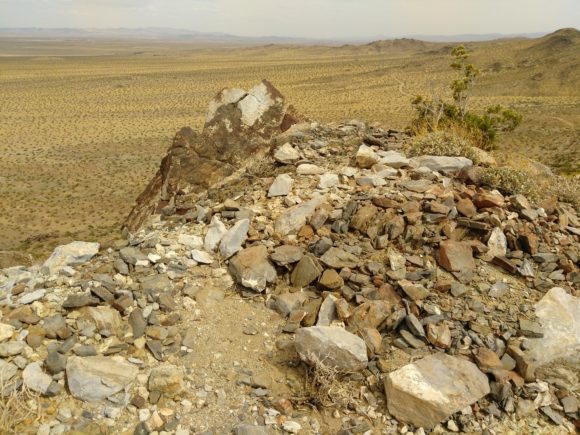
View from on top of un-named Nickel deposit
Off we went, to go visit the un-named nickel deposit. The wind on our first visit makes the location very memorable. We can have wind gusts over 65 miles an hour on some days around these parts and that day the wind was so forceful we were quite worried we would be swept off the mountain. Maintaining a tight foothold, we explored the area, looking for bright green crystals of annabergite and chrome green uvarovite garnets. Instead, we found the meaning of “silicic dike”! All of the minerals we have found at this location have been frozen in blocks of silica. While this does not do anything for us mineral collectors, it makes for a unique lapidary material. The same stuff as the classic German “Nickel Quartz”, this green stone takes a nice polish and the contrast of white and green makes for an interesting stone. Floating around in this silica, tiny bits of chrome green uvarovite garnet are found, while nothing to write home about, they do add a little something to some of the slabs and tumbled stones we produced out of this ore. If there were crystals here, this could be one of my favorite locations, but even in massive lapidary form, this in a rare treat in terms of mineralogy, a geat view-point in this area of the North Calico mountains and yet, just one of many locations in a short distance in this mountain range.
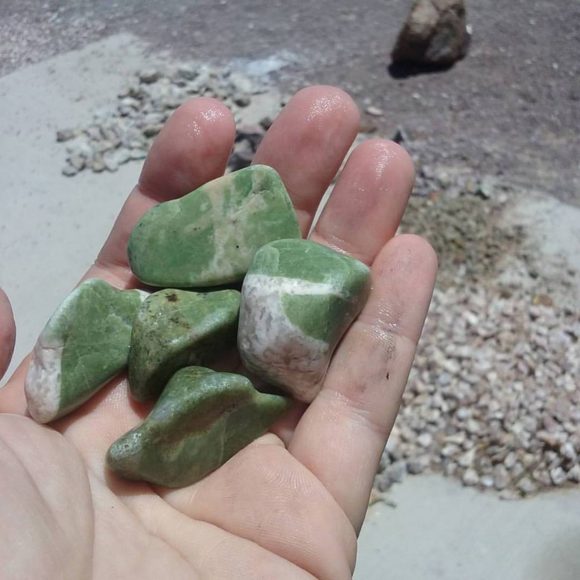
Tumbled nickel quartz from the un-named Nickel deposit
Just off to the Southwest, the road takes you to the Puerto Negro mine, a series of rock dumps that stop at a mine entrance a few hundred yards south of the beginning of the dumps. This is an Arsenic mine that produced an arsenic rich ore with the occasional bit of calcite and realgar. While I have not found many specimens at this location, the few I have found have been quite uncommon, orangy red realgar in layered clear calcite crystals. Drive North to connect back with the power line road and drive over to the next canyon to the South, taking Madrugador Road, home to several prospects for copper and gold, before heading back out to Fort Irwin Road. These gold deposits do not have much in the way of collectables for mineral or lapidary enthusiasts, however, they do produce chunks of calcite and masses of red, iron stained, quartz.
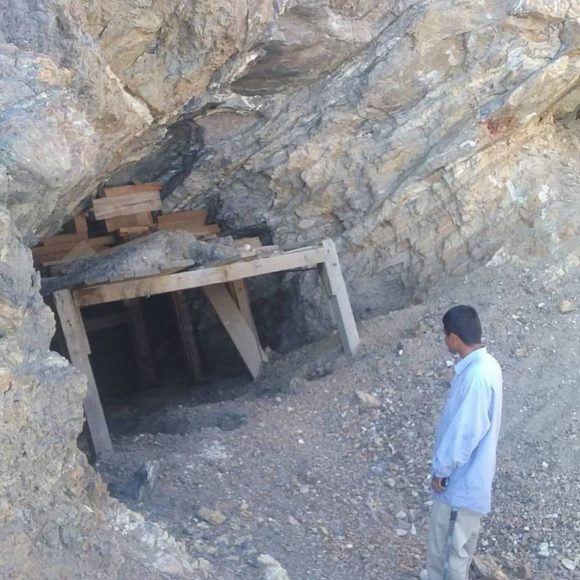
Entrance to the Arsenic Mine, the Puerto Negro
From here, it is time to go across Ft. Irwin Road, just a few hundred yards to the South, a road stretches out towards the Northwest, reaching out to several locations were crystals and lapidary materials can be found. The road is a very nice, mostly smooth flat desert dirt road. There are a couple tiny washed out areas, but most any passenger car can navigate the area. Immediately to the North, a small set of ridges spread out, the ridge to the West of the hills contains two locations to explore. A massive Barite locality called the Ball mine and a funky Wollastonite deposit with some odd rocks to be found. You pull off this new dirt road and into a wash road that loops around, park here and hike into the mountain valley to find the Ball mine, which is easy to see and high up on the hillside.
The Ball mine was a series of tunnels and surface workings that produced massive white barite, which can be found in abundance as lumps of heavy white rock. While unassuming, when exposed to UV light, these lumps glow a pleasing green and pink. There are tons and tons of this material laying around the mine adits, so you will have plenty to choose from. Continuing North into the canyon you will come across a Wollastonite deposit that has bits of calcite and some black rock that is said to be chromium bearing.
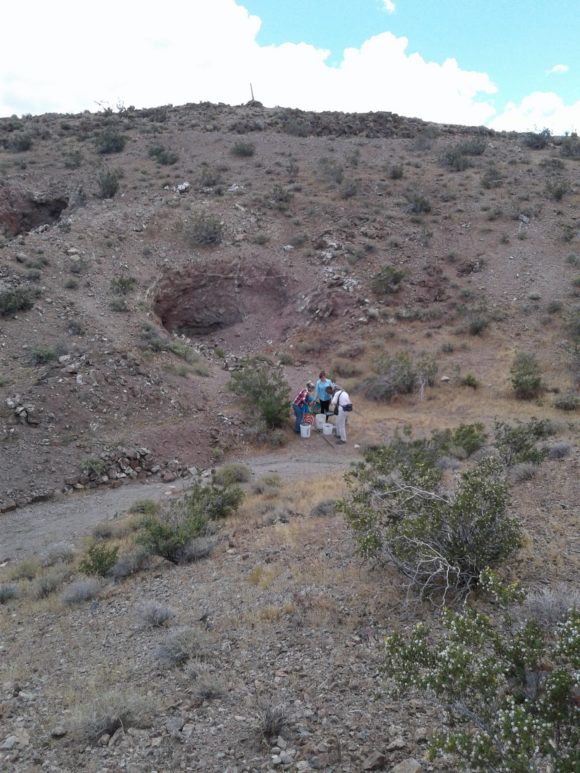
Rockhounds collecting Garnets at the Nobel Prospect
Back on the main dirt road, you continue Northwest for a mile or so until you come across a faint road headed South which leads to a large pile of rocks in the middle of the flat desert. It is unusual to see a pile of rocks such as this, however, this outcropping of rock is a happy accident for all of us. Here you can find a great deposit of Onyx, a flowing series of banded tans and yellows, along with bright red caused by iron impurities, along with areas of quartz, in the center of the stones as well as on the surface. Druzy specimens of quartz and calcite can be found, the only drawback is the size of the matrix they are sometimes attached to! The large chunks of stone cut to reveal beautiful patterns, while being nice and crack free, solid cutting material. It is remarkably easy to find, within a half hour at the location, cutting material to keep you occupied for days and weeks.
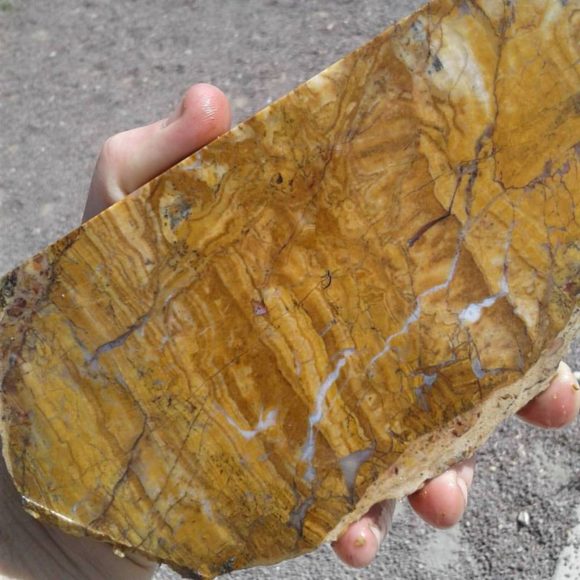
Sliced Travertine from the large travertine outcrop in the North Calico Mountains
Traveling only another thousand yards to the West along the main dirt road, you come across the Noble prospect, a mineralized zone consisting of a short canyon wash to the East, with short adits that pushed out garnets, quartz, epidote and calcite. While we were hoping for garnets trapped inside calcite pods, these garnets are frozen in a quartz matrix, an while crystals can get up to an inch across in size, there is no way to free them from the host rock. Still, terminated garnets can be found in this area and the masses of quartz, epidote and garnet make for interesting lapidary materials. Just a short distance from this wash, a road takes you a few hundred feet to a bench in the mountainside, filled with boulders containing calcite crystals and quartz druzy, the druzy areas measuring up to and over one foot in size on several of the boulders. The trick is to find specimens that are small enough to take home. Several pieces showed evidence of layers of quartz covering and replacing the calcite crystals, which make for very interesting mineral specimens.
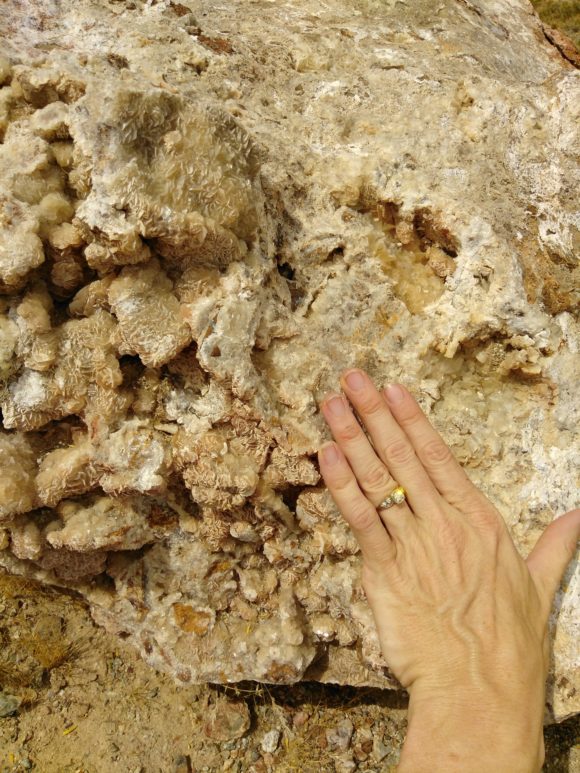
At the Noble Prospect, Boulders of Calcite with Crystals growing in vugs can be found.
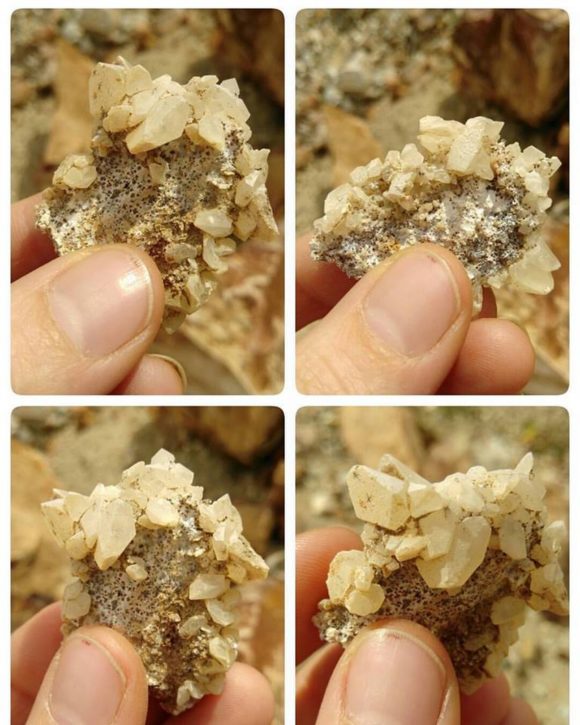
Calcite crystals plucked from the walls of the Noble Propsect.
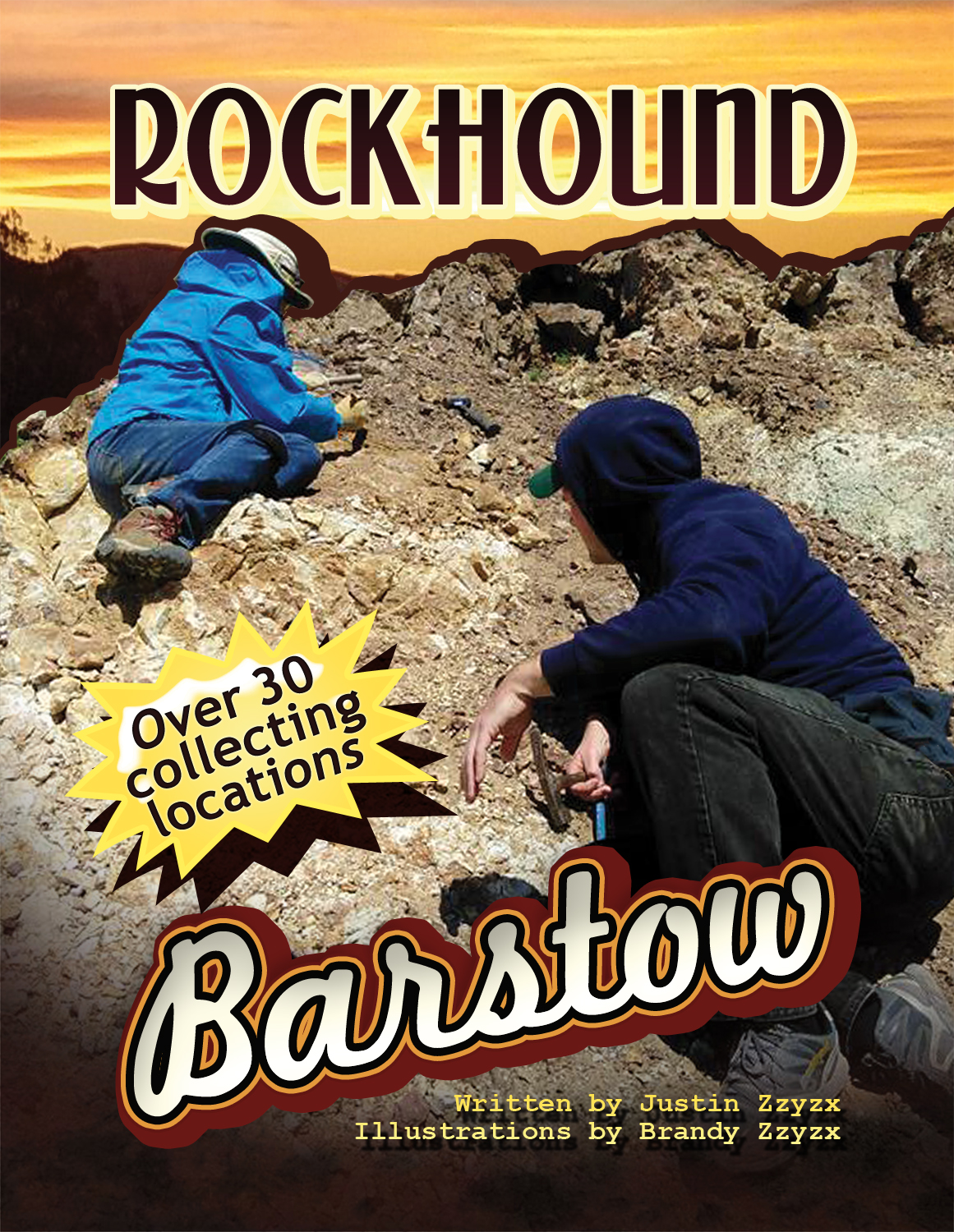
If you like this article, check out the 28 page full color field guide “Rockhound Barstow” for sale online at the following links
Buy it on eBay
Order it on Amazon, or Buy it for Kindle eBook Readers
Or, hey, here is the map…

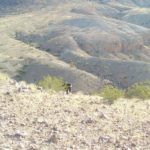
While researching mineral locations for the field guide “Rockhound Barstow” we noticed a few different fluorite deposits listed with vague pinpoints associated. One of our favorite spots to visit is the area south of Afton Campground.
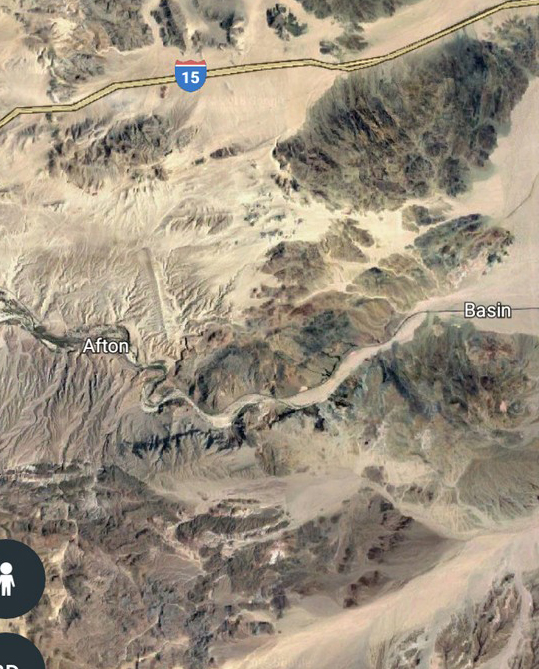 Highway 15, halfway between Las Vegas and Los Angeles with Afton and Basin, the West and East ends of Afton Canyon seen and the popular agate/jasper collecting spots of the North Cady Mountains in the lower half of the map. Afton Canyon is a remarkable place, featuring dramatic walls surrounding miles of washes leading into the Northern Cady Mountains, a wonderland of agates, jaspers and various mineral oddities. To the North, there are two exits that will take you from the 15 down to Afton Canyon and the North Cady’s. Afton Road will take you to the campground and for those with 4×4, you can take the Spanish Trail East and you’ll pop out on the other side of the mountain, otherwise accessible by Basin Road, the next exit Northbound on the 15 from Afton Road. Taking Afton Road will get you to the campground where you can proceed into the area on foot, or, by taking Basin Road, you can drive to the deposits on rugged dirt/rock/sand roads.
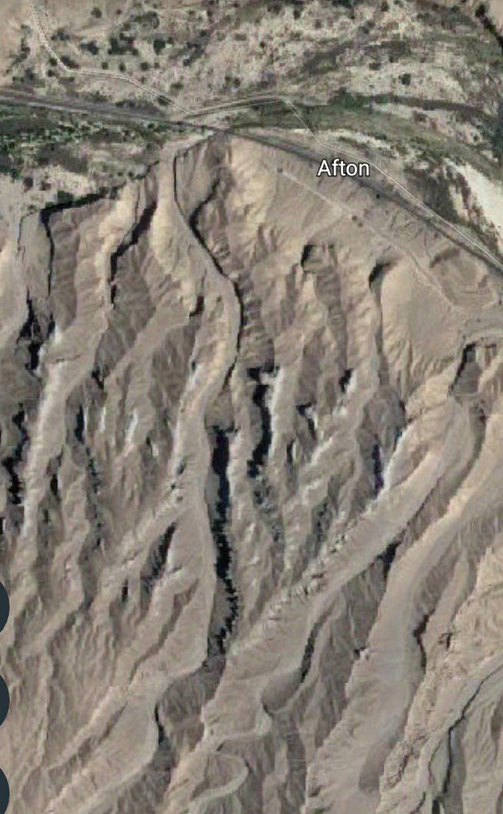 Afton Campground with parking, leading to the large canyon, Pyramid Canyon, with the popular collecting site Hanging Canyon seen in the center, just to the East of Pyramid Canyon. For our trip, we can go two ways. We can drive in on Basin Road and then take a series of washes and mountain roads and bam, you can drive right to the fluorite prospects. It is a tough drive and with some satellite maps and planning, you can attempt to reach the location via vehicle. We do not go in this way. We walk in from Afton Campground, through Pyramid Canyon. You start by going under the railroad bridge and across the shallow waterway of Afton Canyon to head South into the giant canyon wash. This wash continues for about 1.6 miles taking you through some magnificent large canyon walls, ending at a giant block of black basalt with a waterfall opening some 100+ feet from the bottom. Instead of walking to the back, we walk up a switchback .2 miles before the end, which takes us up to the top of the canyon. A road and path lead you to the upper wash, which would spill out into the lower wash we just hiked up. This whole area is a treasure box of crystals and lapidary goods, with different things found on different hills. Tons and tons of red and yellow jasper is found all over, zeolite included agates and jaspers, crystals of quartz and calcite and even some odd-ball zeolites, casts and epimorphs are found tumbling out of the basalt hillside. The basalt here features areas of intense gas bubble inclusion, resulting in literally MILLIONS of quartz pods filling the ground. Some of these have crystals, some of them did weird things, like replace zeolites and anhydrite, some of them have calcite on top of quartz, sometimes the quartz is over the calcite. It is a fun, uncommonly visited, vast in area, place, most often visited by people in search of agates and jaspers.
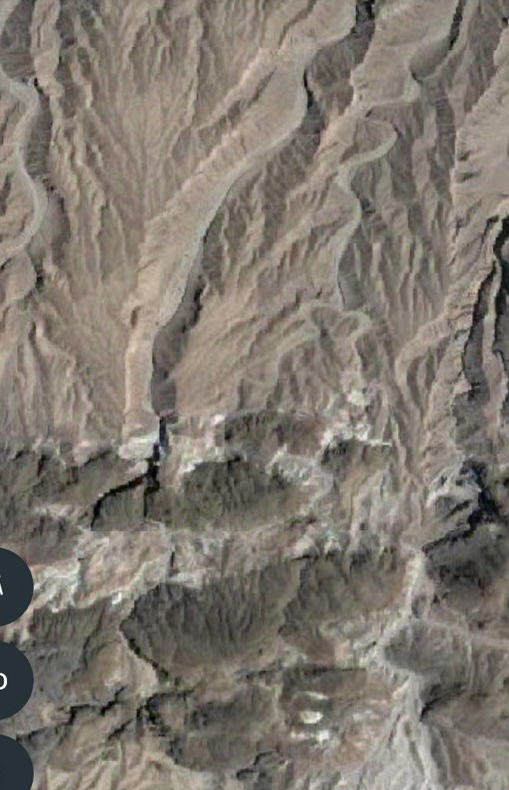 The Pyramid Canyon wash leads you to the near end of the lower canyon, then a out of use dirt road takes you up and to the Eastern side of the canyon and up into the black basalt deposits that make up the upper part of Pyramid Canyon. 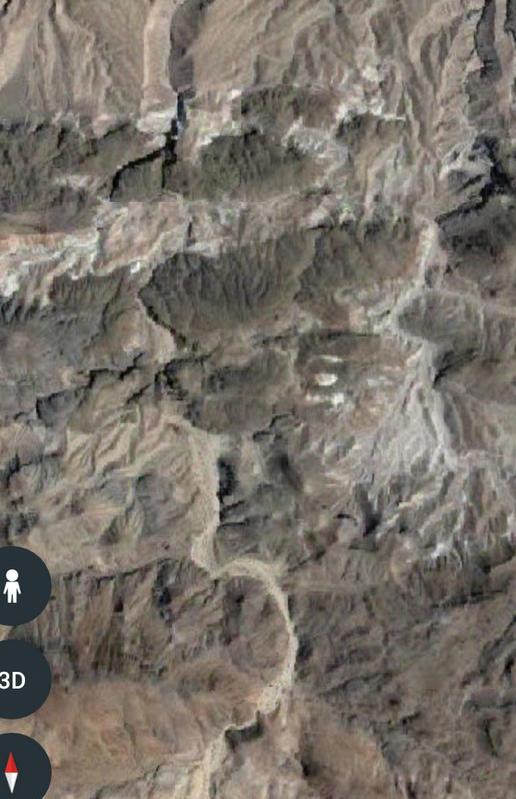 Satellite view of the basalt hills at the end of the Pyramid Canyon heading to Afton Campground. At the bottom of the photo you can see the “Mixing Bowl”, to the right of that the Fluorite deposits are found. Continuing South on the upper wash of Pyramid Canyon you come to what we call the “Mixing Bowl”, which is an area that had three washes mix into it, making what looks like a pool in the wash. To the South there is a 10 foot waterfall wall which most can scale up with little assistance. To the SouthEast there are two washes, both of which lead to the Fluorite deposits of Afton Canyon. Yet, they are not really terribly close to Afton Canyon, we just had to walk nearly 2.7 miles to get there, from Afton Canyon. Maybe the Fluorite deposits of Near the wash that leads into Pyramid Canyon did not have the same ring.
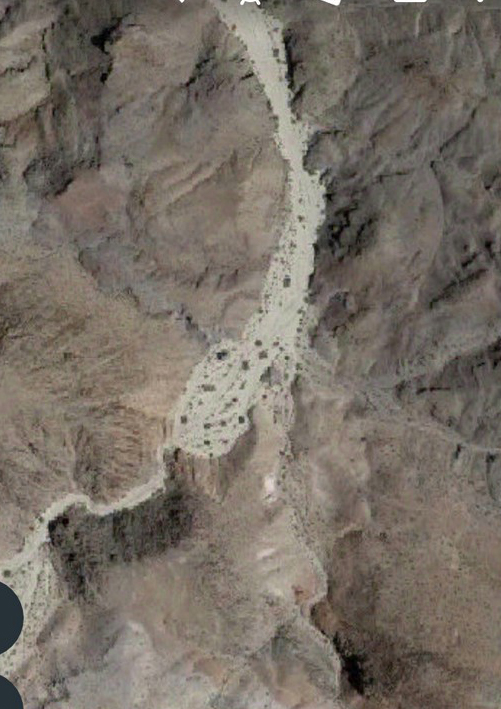 Satellite view of the “Mixing Bowl” near the end of the wash above Pyramid Canyon 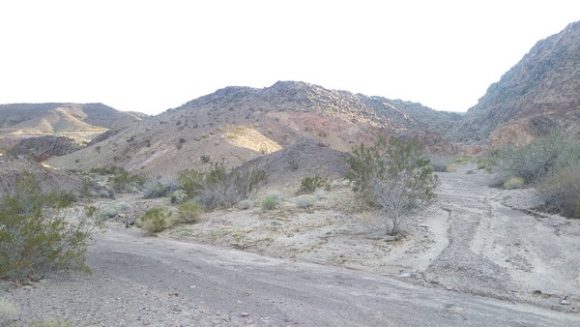 Mixing Bowl near the furthest point of Pyramid Canyon. Waterfall to the Right leads to the Cattail fossils, to the Left is the wash that leads to the Fluorite deposits. 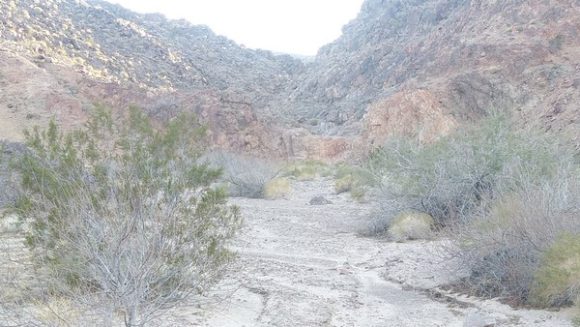 To the North of the “Mixing Bowl” there is a 10 foot tall rock wall, a former waterfall, you have to climb up, or down. If you hop up the waterfall you can walk over to a deposit of “Cattail” reeds, or Typha. You will see hundreds of reed stalks along with dozens and dozens of pods of seeds, the familiar “Cattail” part, which have been turned into quartz and calcite geodes, sometimes with banded red and white jasper/agate. Those ones are particularly showy. Some lapidary collectors have taken advantage of the pretty banded agate/jasper available, yet literally tons more are there, not including another deposit further North with the same type of material. More deposits of Typha fossils must exist in more locations in these hills.
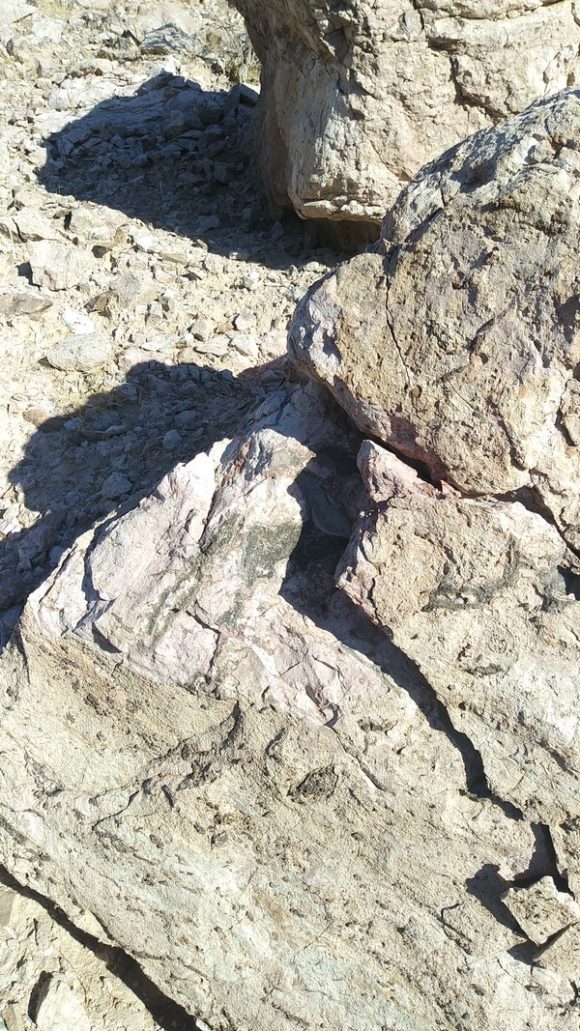 Fossil Bearing Matrix of Typha, Cattail reed fossils. They have been silicated and contain colorful jasper and quartz crystals. 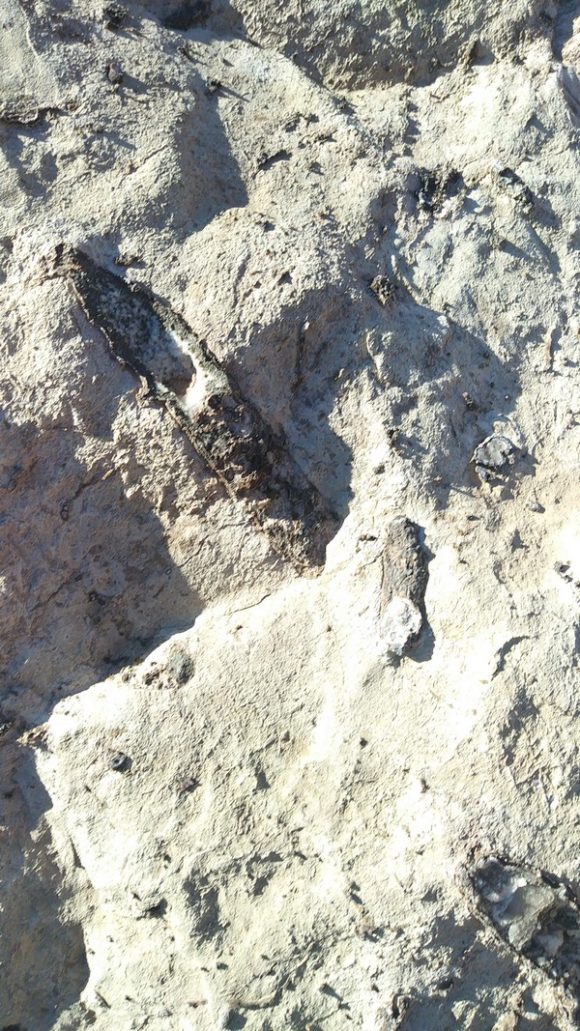 Cattail or Typha, fossilized and replaced with a core of quartz crystals. You can see two of them in the center of this photo. 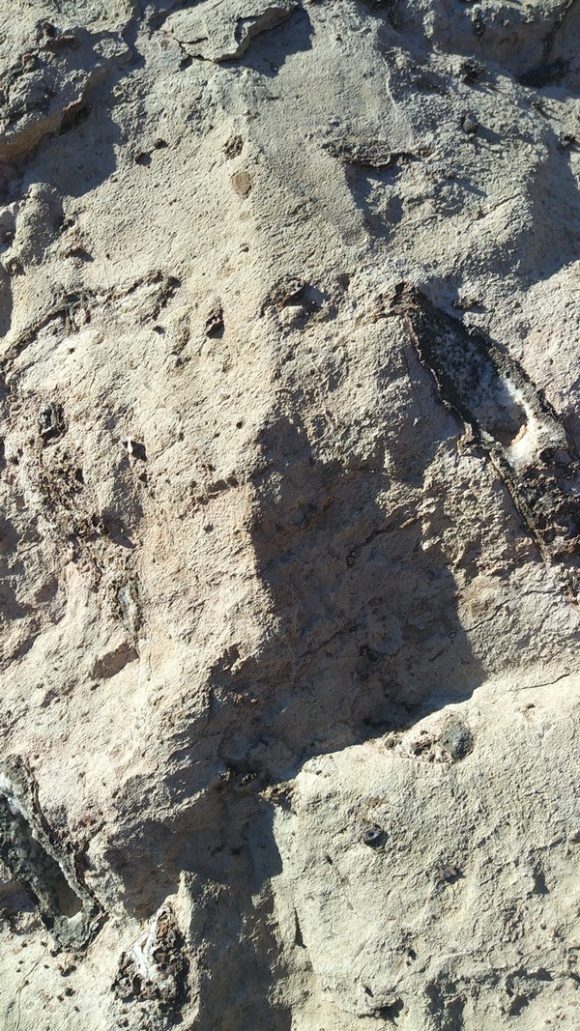 Hollow casts of Cattail fossils found in Pyramid Canyon From the cattail fossil site, there is a road that takes you Westward towards the Basin Road area via a DEEP dip Southwards via Baxter Wash. Just a short distance West on this road and a faint turn off will be visible on the North side of the road. This turn off leads you to the start of the Fluorite prospects.

|
If you like this article, check out the 28 page full color field guide “Rockhound Barstow” for sale online at the following links
Buy it on eBay
Order it on Amazon, or Buy it for Kindle eBook Readers
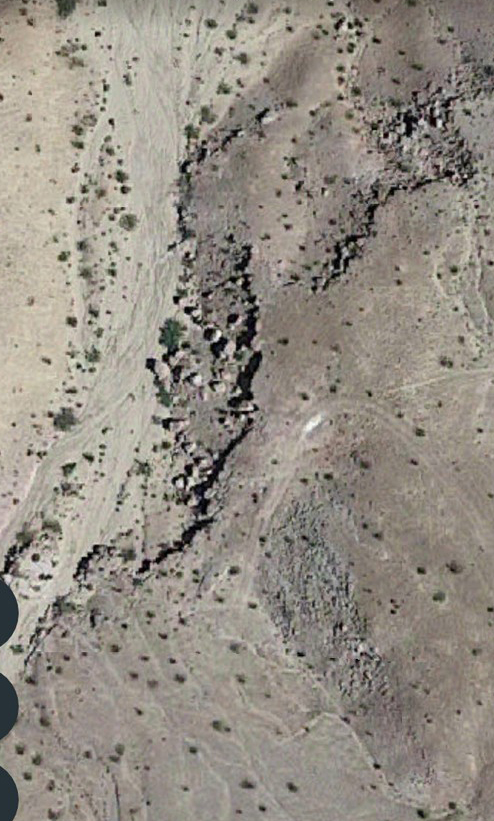 The Boulders to the side of the wash contain numerous fossils of Cattail reeds. Note the faint road to the side. This road is navigable from Basin Road. 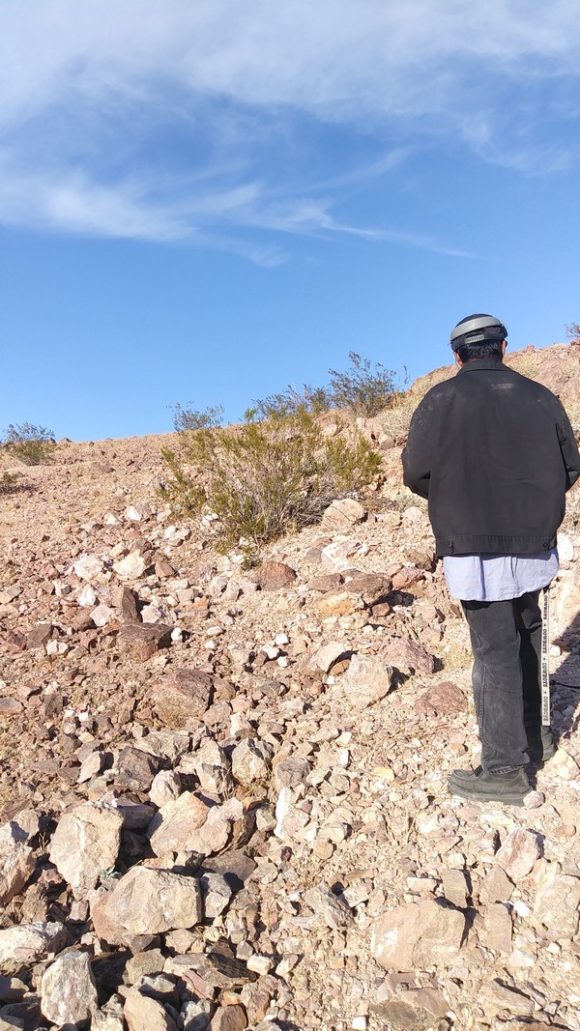 After 2.7 miles of hiking, we found the start of the Fluorite deposits of Cady Mountains. The area is quite long, up to a mile of prospects dart the hillside. The fluorite found here is green and purple and requires some real work to move hard rock and discover undamaged crystals that have not been hit by the sun. The sunlight turns these green crystals to a bleached white, as with most fluorites. Even with the sunbleached specimens, the UV reaction on these is amazing, LW, the most common type of inexpensive UV light source, makes this material GLOW!
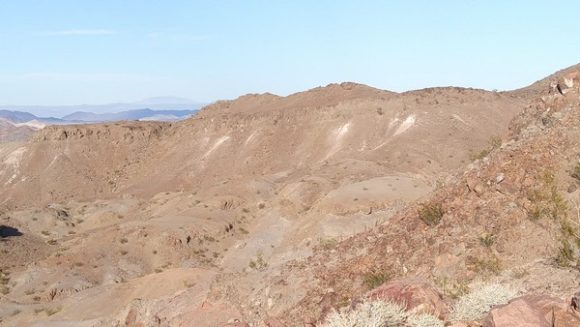 The white areas in the distance are all prospects for Fluorite. The deposit spans nearly a mile in distance. 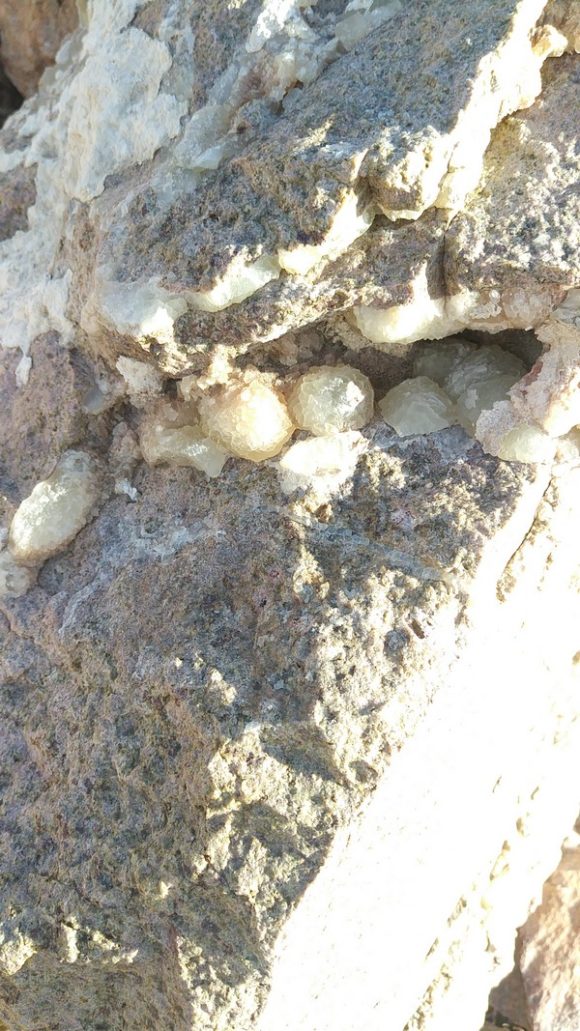 Crystals of Fluorite hidden away inside a pocket on a boulder at one of the many prospects for Fluorite in the Headwaters of Pyramid Canyon. 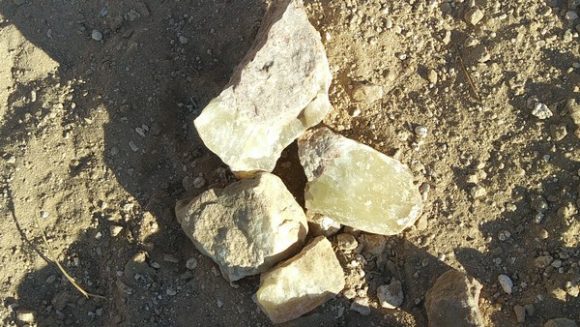 A few specimens of Fluorite we found as we were looking for the Afton Fluorite Deposits. 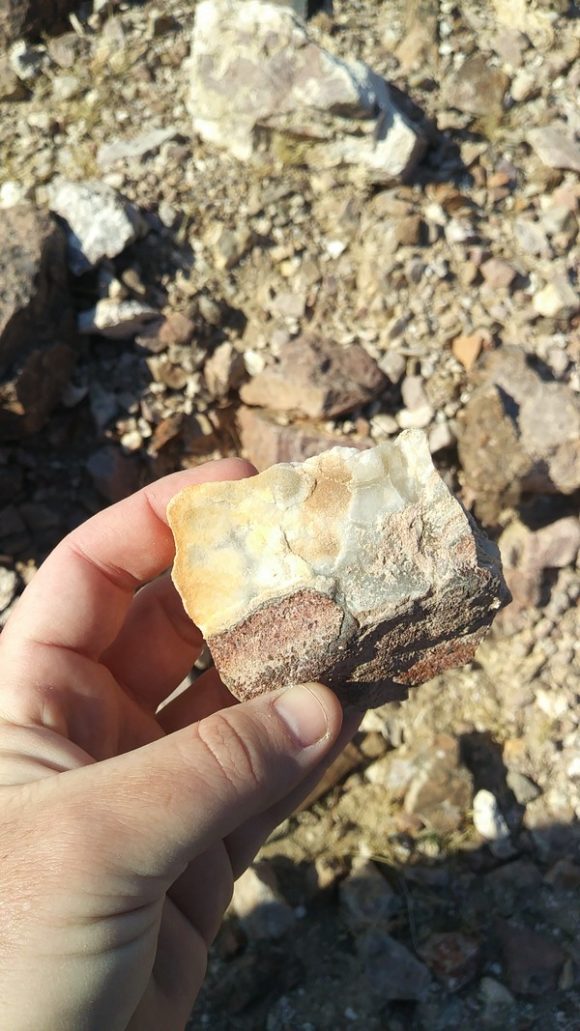 Skin of Green Fluorite on Matrix 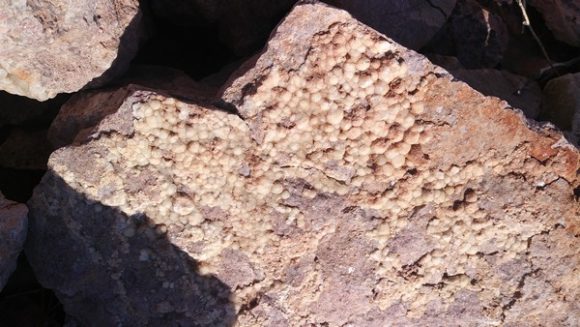 Spheres of Fluorite on Matrix. Originally Green, faded in years of sunlight. As you can see from these photos, hard work and tools are required to unearth new, colorful specimens. After learning about the historical mixup on the true location of this deposit, we hightailed it to the location and hiked the 2.8 miles of washes, switchbacks, trails and amazing scenery that if you are near this area, you really should come and see. We had to hurry and hike back out just as quickly so we could get out before nightfall. While we did not uncover any amazingly bright green crystals, we did not dig, we just examined what we found on the ground and in the ground at the prospect holes around the area. It takes about 1 hour to walk from the campground to the “Mixing Bowl” waterfall in the upper part of Pyramid Canyon. Driving into the area takes about 45 mins to an hour from Basin Road. Walking in you get some serious exercise! Driving in, you can haul a lot of tools. Walking in you really get familiar with the landscape and areas, driving in, you get to business. Either way, the Fluorite deposits 2.8 miles South of Afton Canyon, near the headwaters of Pyramid Canyon, are ready for you to come and visit.
Plenty to see and explore all around this area for those fit enough and respectful enough of our beautiful desert mountains.
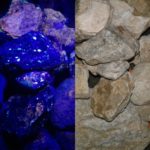
I enjoy seeing rocks light up under Short Wave Ultra Violet light, so do millions of other people in the world. It is exciting to see brilliant colors coming from, what commonly is, a not very visually stunning rock. While large exotic crystals can fluoresce, many times it is something drab and visually unappealing that shows brilliant reaction to “black light”. As the field trip leader for an active group of rock hounds, my monthly trip for February of 2017 was to the area known for brightly fluorescent rocks in the Shadow Mountains, just West of highway 395, in the high desert of Southern California. 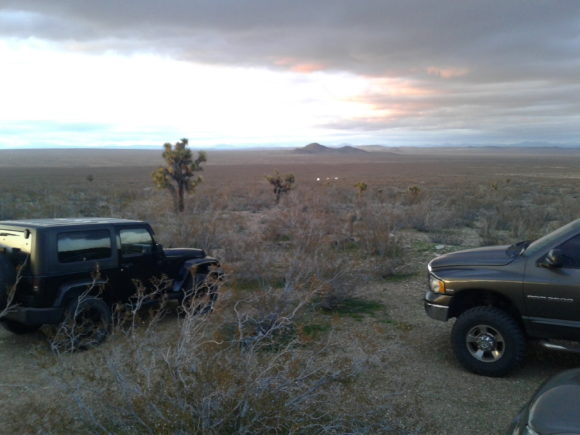 Every month we lead a field trip for the Mining Supplies and Rock Shop in Hesperia California, visit the shop and join us!  This photo shows the typical rocks found at the Shadow Mountain Tungsten District under normal light and under SW UV light. To start out my planning for this trip, I did a basic Google search for what I thought the name of the mine was, the “Princess Pat Mine”. Google brought up some pages with various bits of information, some photographs, but no real indication of where the mine was specifically located. I then turned my attention to MRDS, as talked about in Rockhounding 101, this site can give me a list of mines, pinpointed on a map, showing what has been found in the area. It was a surprise to see that while there were a dozen or more deposits for Scheelite, the highly UV reactive mineral we were after, none of the mines were called “Princess Pat”. However, looking at the Google map, I noticed the road that takes you right to the majority of the scheelite deposits was called “Princess Pat Mine Road”. In fact, you simply turn west off the 395 onto this unmarked road and go for 5 miles until you hit the collecting area. But, why was I having such a pain finding the “Princess Pat Mine”?
I broke open Pemberton’s “Minerals of California” to find an entry for the Shadow Mountain Tungsten deposits on page 337, where it states “6. In the Shadow Mountains, on the northwest flank of Silver Peak, there are a number of scheelite deposits consolidated as the Just Associates quarries. The scheelite occurs in quartz veins cutting garnet-epidote-quartz tactite.” – however, no mention of the “Princess Pat Mine” – So, could it have been that the name “Princess Pat” was older or newer than this 1983 tome of California minerals? With this, I pulled out the Murdoch and Webb version of “Minerals of California”, 1966 edition, which leaves out the Shadow Mountain tungsten mines from the entries on scheelite in San Bernardino County.
Luck would serve me up a reference to “California journal of mines and geology”, Volume 49, which featured a fantastically in depth article on ore bodies of San Bernardino County, which reads
Just Tungsten Quarries (Just Associates, Princess Pat, Shadow Mountains Mines). Location: sees. 30 and 31, T. 8 N., R. 6 W., S.B.M., on
the northwest flank of Silver Peak, Shadow Mountains, about 13 airline miles west of Helendale and 14 airline miles northwest of Adelanto.
Ownership : Just Associates, E. Richard Just and Oliver P. Adams, 726
Story Building, Los Angeles, California, own unpatented claims totaling 440 acres. The property is leased to Just Tungsten Quarries, E.
Richard Just and associates, 726 Story Building, Los Angeles, California.
The deposit, now known as the Just Tungsten Quarries, was discovered in 1937. Operations from late 1937 to early 1938 by the Shadow
Mountains Tungsten Mines and W. A. Trout and C. A. Rasmussen re-
sulted in the recovery of about 750 units of W0 3 from nearly 3000 tons
of selected ore treated in a 40-ton mill on the property. The operation
was not successful and the mill was dismantled. During the mid-1940 ‘s
lessees mined about 400 tons of ore, and during the late 1940 ‘s the
Princess Pat Mining Company leased the property but apparently produced no ore. Operations from April 1952 to mid-1952 have yielded a
few hundred tons of ore of undisclosed grade.
The scheelite occurs in quartz veins cutting garnet-epidote-quartz
tactite bodies which exist at the contact between a Mesozoic granitic
rock and Paleozoic ( ?) metamorphic rocks, mostly impure limestone and
schist. The foliated rocks strike slightly north of east and dip gently
south. Scheelite-bearing tactite also has been developed, away from the
contact, along beds in the limestone, to form thin bodies of ore separated by barren limestone beds.
The deposit was explored during 1937-38 by 1800 feet of zig-zag
trenches, 10 feet wide and 6 to 10 feet deep, excavated by a power shovel
up a moderate slope in a southwesterly direction. A 65-foot vertical shaft
was sunk near the lower end of this trench system, but no mining was
done underground.
Employed in the early prospecting was a large field-type lamp requiring a 110-volt current, and a portable gasoline-powered motor generator set. This may have been the first practical application of a lamp
of this type.
Ore is being mined from a bench cutting into a trenched area about
50 feet north of the shaft. Mining operations are carried on at night,
and the ore is sorted with the aid of ultra-violet light. Shipments have
been made to both the Jaylite and Parker custom mills in Barstow.
There you go, the “Princess Pat Mine” has the distinction of being a mine that produced no ore.
As it was, the tungsten mines produced little more than some naming confusions and quite possibly some bad debt, as the scheelite riches would never quite materialize from this deposit. Tungsten is an element that was listed by the United States Government as a strategic reserve, as most of our Tungsten comes from China, during WWII it was known that it would be scarce, so efforts were made to ensure production could be met at home. Plenty of trenches and tunnels were driven in this 140 acre unpatented claim, in the end, producing nothing more than a playground for collectors with an UV light.
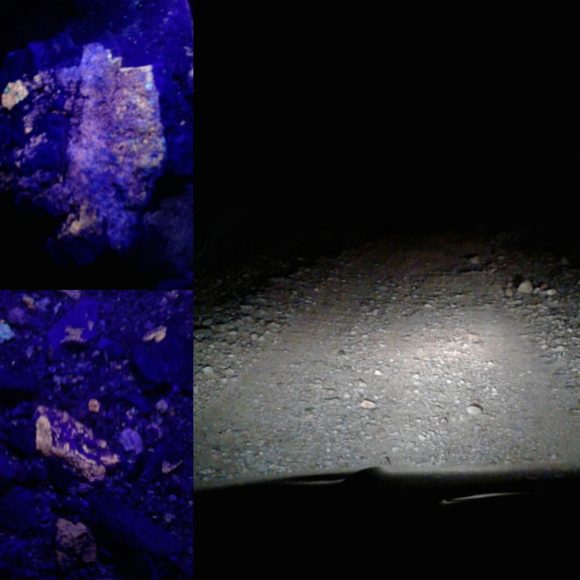 The mostly smooth desert road is littered with rocks that glow under SW UV light There is often a little confusion as to what kind of Ultra-violet light one needs to get the enjoyment out of collecting UV minerals. I have used many varieties of products and I’ve found what I like and what I do not like. Obviously, a light with ample power is what one wants. Small hand held units are commonly available in 6 watt and under, which gives you a reaction when you hold the light VERY close to the specimen. However, the difference between a low wattage light and something in the 9, 18, or even, 36 watts will astonish every viewer. If you want maximum enjoyment out of UV collecting, a dual wave 18 watt light is a sound investment. Some minerals glow under Long Wave (365nm) range, but honestly, I find Long Wave to be the most limited, while Short Wave (285nm), produces amazing effects. When it comes to companies, well, some come and some go, while some are longstanding companies that I do not personally enjoy, when it comes to price vs. what you get, so, I would like to steer you in the right direction. At this time, in winter of 2017, there are no good companies to purchase a UV light from on Amazon.com. In fact, I would push you in two directions. #1, UVTools.com – They have been producing some fine lights, which come accompanied by a great informative kit. I highly recommend all the units they sell, even the sub-9 watt lights. #2, on eBay, the seller topazminer_minerals_and_fossils has been having great deals on a fine selection of high powered lights, at very reasonable prices. I would suggest viewing their offerings when looking for a great UV light.

|
If you like this article, check out the 28 page full color field guide “Rockhound Barstow” for sale online at the following links, now including the Princess Pat Mine Area, indepth!
Buy it on eBay
Order it on Amazon, or Buy it for Kindle eBook Readers
As part of the field trip series that I lead for the Mining Supplies and Rock Shop in Hesperia California, we took a trip out to the “Princess Pat Mine” area, or, as it should be known, the Just Associates Tungsten area, or, even still, the Shadow Mountain Tungsten area. You simply follow Princess Pat Mine road from highway 395 for 5 miles and you will find yourself facing the various prospect pits and trenches filled with cobbles and boulders of mostly white rocks that will glow readily under short wave light. You will see bright orange from the potassium rich calcite caliche, you’ll see bright green from the uranium included quartz. The bright white/blue scheelite is the real winner, appearing as belts of star-like dots in the rocky background. Rarely, one can find bright red from the wollastonite found in the area.
 We have lead field trips for various groups and organizations 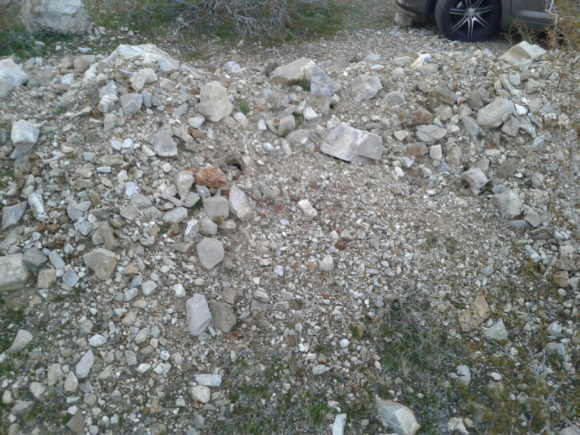 This pile of ore rubble was waiting for us at the parking area 1/10th of a mile from the start of the major trenching. This pile of rocks glows brightly if you do not wish to go into the rocky tailings beyond. A group of about 30 of us descended on the mine area around 5pm, getting a view of the area before the sun set, by 6pm we were ready to see some rocks glow! Many of us came equipped with various powered UV lights. Some of the inexpensive LED Longwave lights were causing the calcite to glow a slight pinkish, but that was all, while the Shortwave lights were causing the whole area to light up. Everything around the area was glowing light wild, which lead to lots of happy rockhounds and many people remarking that they could not wait to come back and bring friends to show this wonderful area to. In this lonely desert, with no lights besides the moon and the stars, one can get some amazing results with a short wave ultra-violet light!
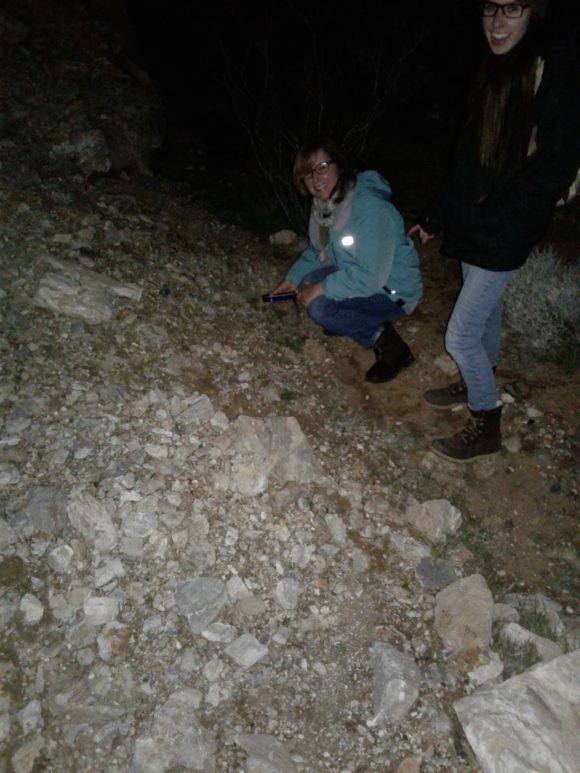 There were plenty of trenches pushed into the mountain which make great areas to illuminate the walls in search of black light rocks 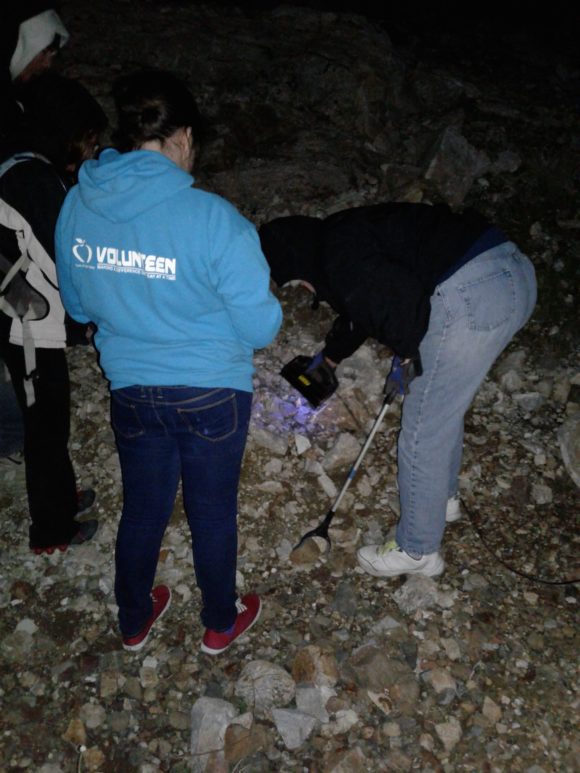 In the dark, scanning for rocks that react to SW Ultra Violet Light is a blast! 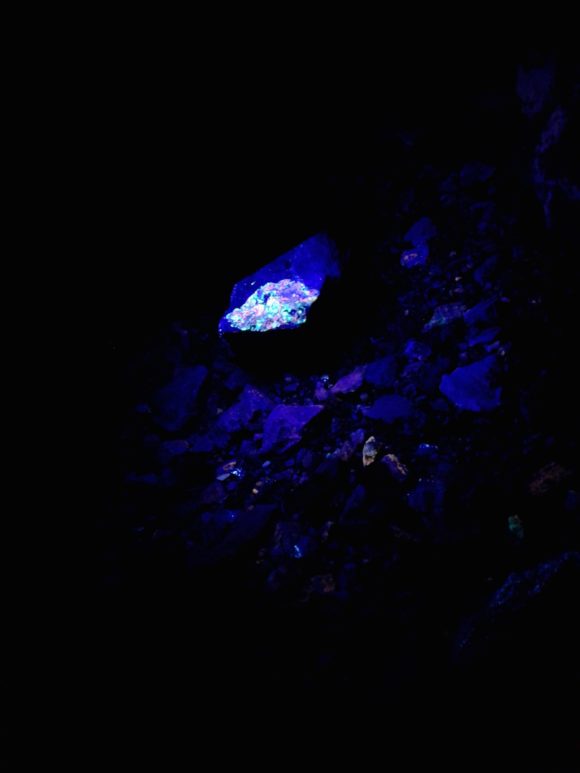 Here is a rock responding to SW UV light on the mine dump at the Princess Pat Mine/Just Associates Mine So, go out and enjoy a day or night at the Shadow Mountain Tungsten District. There are no active claims, there is no ore of worth, it is just you and the coyotes, howling at the moon and looking down at the twinkling scheelite stars…
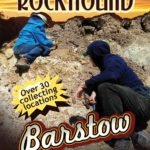
 Check out the new expanded Rockhound Barstow, in full color and larger size! UPDATED 3rd Edition Released August 2020 – Get it now direct on a PayPal link, or check it out on Amazon, eBay and Etsy
The Mojave desert is a mineralogically rich area. One small town of less than 30,000 people serves as a great jumping off point for dozens of fantastic collecting sites. Many of these locations are Southern California classics, found in field guides dating to the early 1940’s and surprisingly, still producing to this day. The Cady Mountains are an endless source of material. You can be sure that enough time spent in the loving folds of the Cady mountains will reveal some mind blowing treasures to the lapidarist.
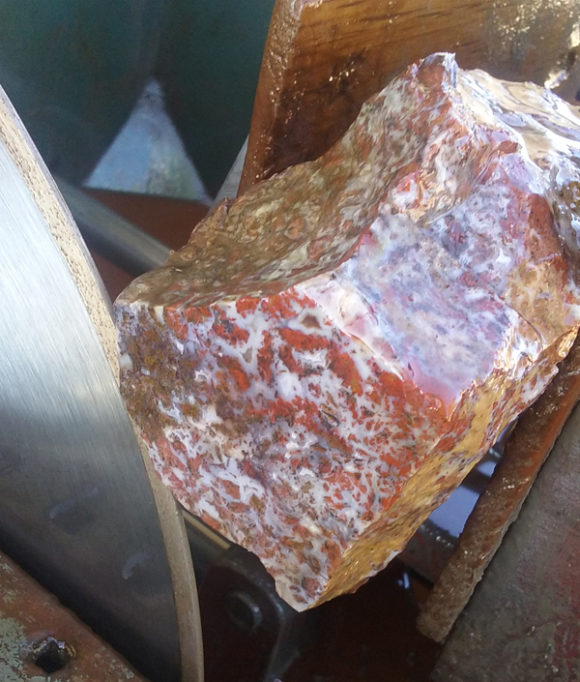 Top Notch Agate being cut into slabs. The Cady Mountains produce beautiful treasures you’ll love working with! 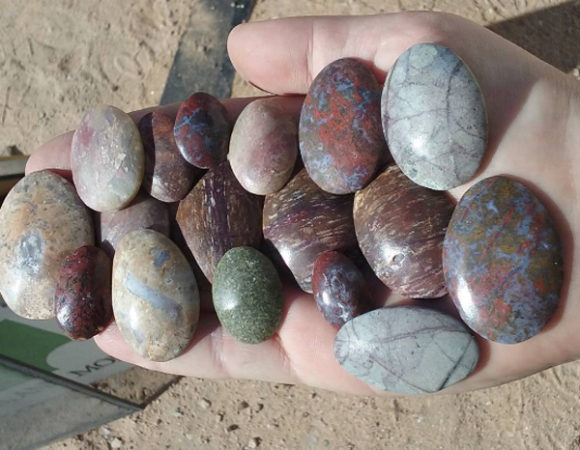 A sampling of cabochons made from material found in the Cady and Alvord Mountains Just a few miles outside of Barstow you hit the Calico Mountains with a vast silver district, an amazing series of borate deposits, celestite for days, tons and tons of fine selenite and ample supplies of petrified palm root just pouring out of the hills…and silver lace onyx and calcite concretions that can have celestite and quartz replaced spiders and flies inside! That is just the things you can find in a small mountain range just four miles north of highway 15!
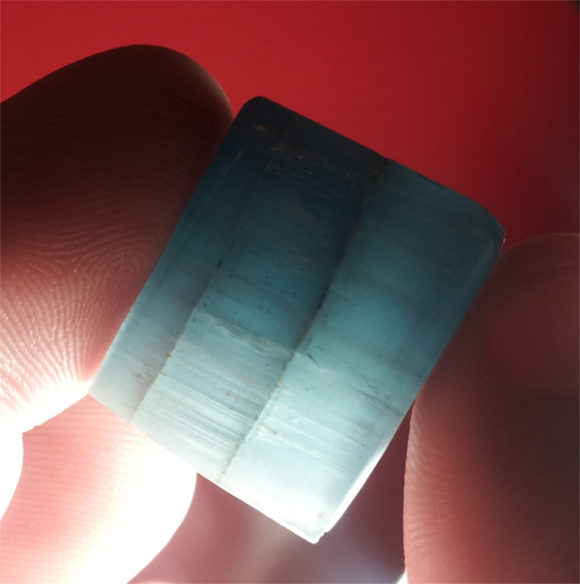 Polished Celestite from one of the many celestite deposits found along with the Borates of the Calico Mountains 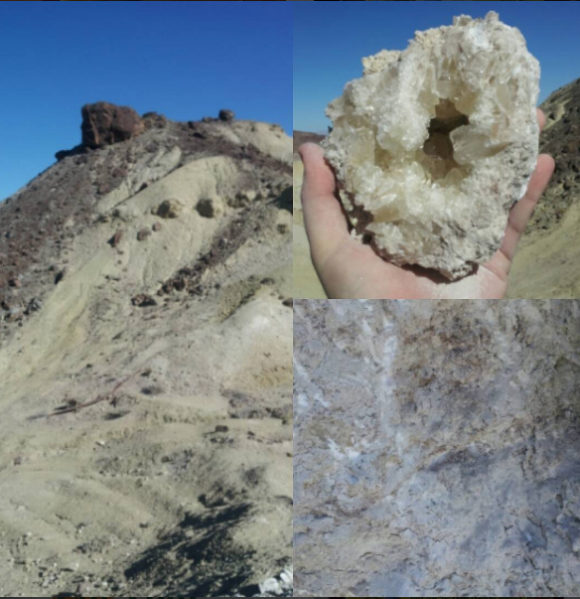 Gem crystal clusters of Colemanite are found in the Calico Mountains, ready to come home with you! 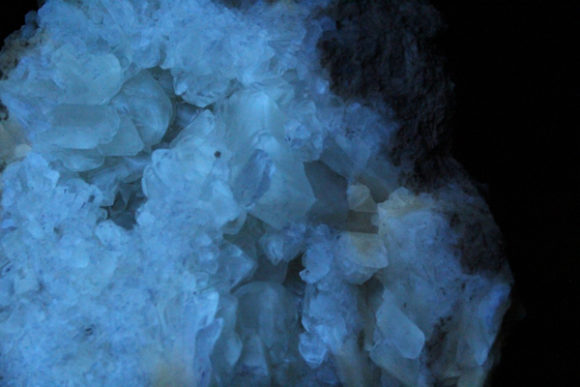 Colemanite glows bright in Short Wave Ultra Violet Light, like MANY of the minerals found in the area. One of the reasons Barstow is such a great starting point for rockhounding in this area is the prime location. Just 2 hours north-east of Los Angeles and 2 hours south-west of Las Vegas, this town has most everything you need for traveling in this area. Gas, groceries, hotels, restaurants, even the Diamond Pacific Rock Shop, attached to the Diamond Pacific Lapidary Equipment factory. Emergency services, like tire and vehicle repair can be found in Barstow so that even in the worst of conditions, there is somewhere “local” to take care of any problems. Convenience is what Barstow provides and there is no reason why that is not a good thing!

|
Buy it on eBay
Order it on Amazon, or Buy it for Kindle eBook Readers
Who better to write and produce this Barstow rockhound field guide than the field trip leaders, Justin and Brandy Zzyzx – locals to the area and avid rockhounds, each of the locations in Rockhounding Barstow have been visited by Justin and Brandy. Justin wrote the text and Brandy designed the maps, as you can see in the sample below.
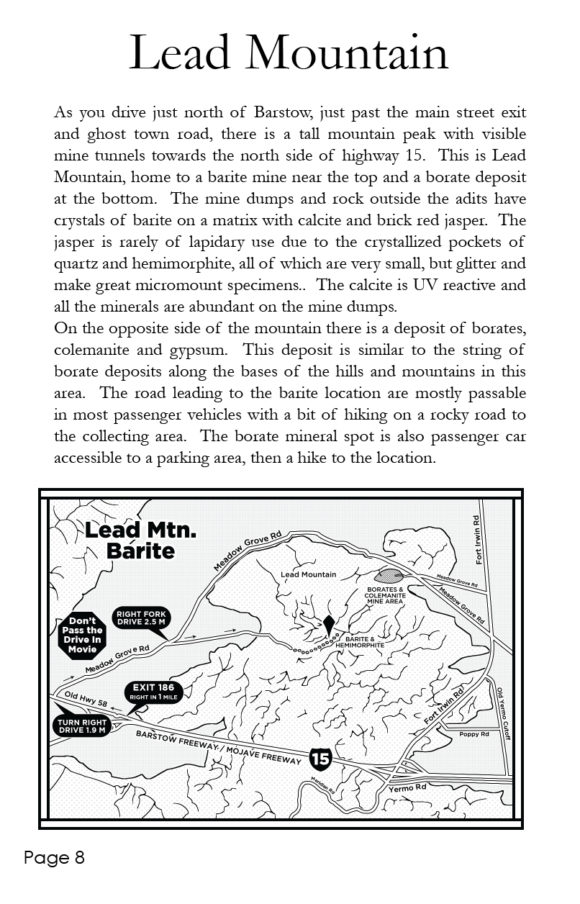 Sample page from the Rockhound Barstow Field Guide – Lead Mountain, just a couple miles from highway 15, a great place to visit and collect colorful crystals! Many of the locations have been written about before, while some of them are being published in this field guide for the very first time. One of the locations that is very exciting is the North Cady Mountain collecting, including the Top Notch claim, prospected by Bill Depue and John Pickett, of Diamond Pacific. This spot has been producing some really lovely material, bright red, golden siderite, fortification and banding of clear and lavender agate. Oh, a day collecting here just can not be beat! You are going to get directions to this very spot and over 30 more locations, just waiting for you to come visit.
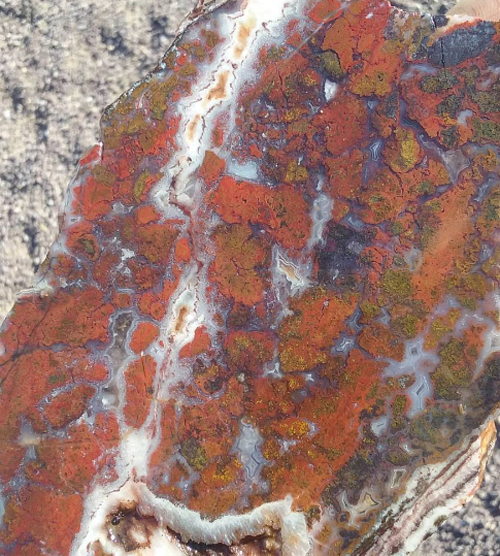 Bright Red and Golden Top Notch Agate from the North Cady Mountains, featured in the Rockhound Barstow Field Guide 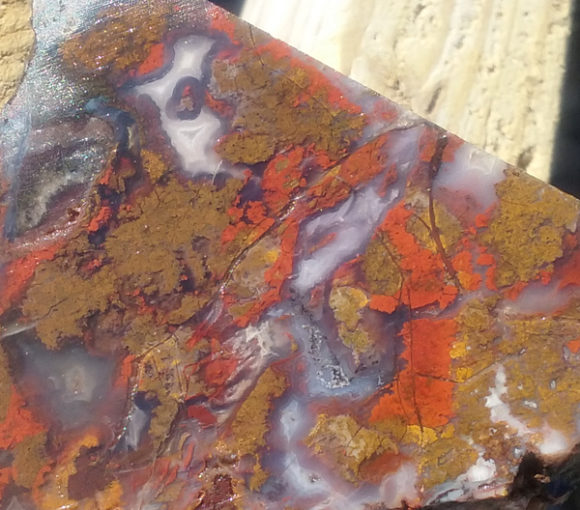 Siderite is not a common inclusion in agates so it is a welcome site to see this material, rich with gold and red along with beautiful gel agate from the North Cady Mountains Another interesting feature is the interactive rockhound map provided in the guide. Simply type in the website address and on your phone google maps will open up and you’ll be provided with a pinpointed map featuring all the locations in the book PLUS additional locations, each of them showing you EXACTLY where to collect. Most of the locations in the books will have cell phone service, allowing you to use the interactive google map as a guided satellite directly to the collecting location. Truly a first in terms of mineral collecting field guides!
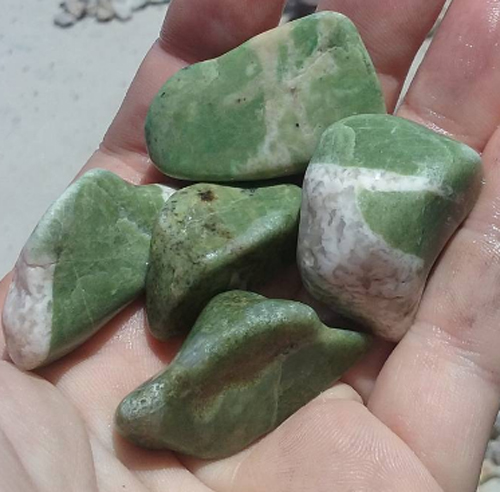 This fun “Nickel Quartz” comes from the North Calico Mountains Nickel Quartz, Wollastonite, Garnet, and so much more await you, with new locations added occasionally. By now I’m sure you are chomping at the bit to find out how to get your copy of this booklet. This digest sized field guide, with a color cover, color photographs of what you can expect to find, over 20 collecting locations, all this can be yours for $14.99 plus shipping and handling! That’s right, just $14.99 plus shipping gets you a fountain of information, right at your fingertips!
Simply use PayPal to order directly by Credit Card or your PayPal account or purchase a copy from Amazon, Etsy or eBay.
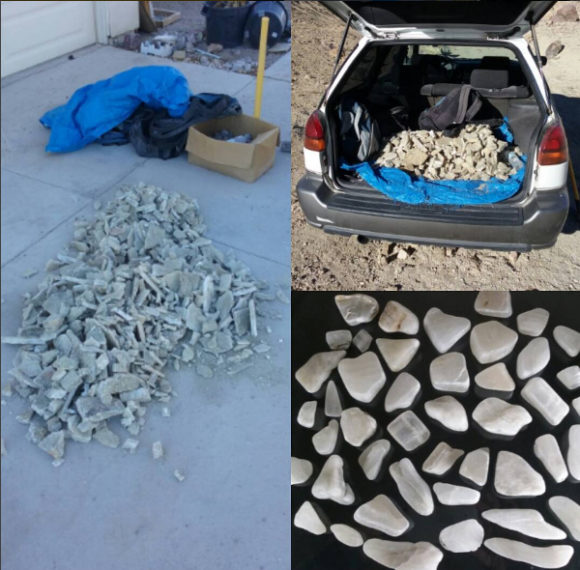 The abundant Gypsum/Selenite in the Calico Mountains is great for tumbling, polishing, carving and collecting. We use it as a water softener. 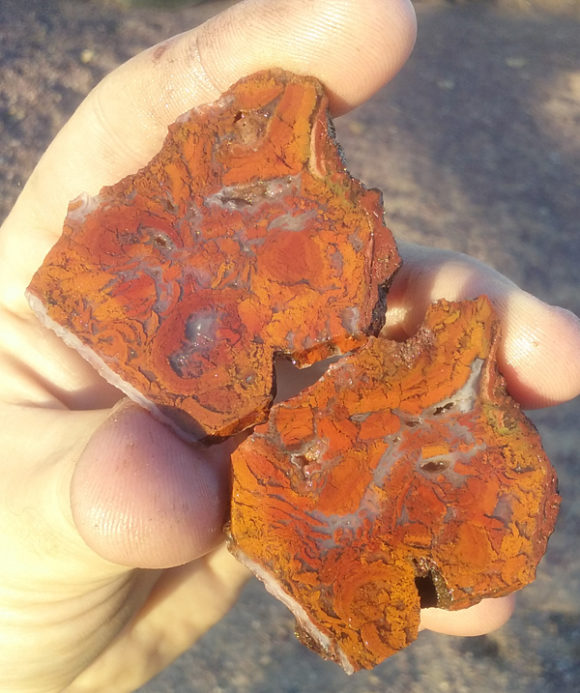 The Lavic Sidling Jasper location is not just limited to the classic areas, but also spilling out to the West and North of Pisgah Crater, as you’ll see in the Rockhounding Barstow Booklet 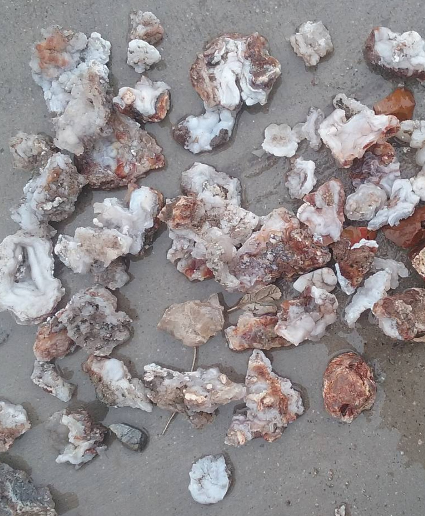 Chalcedony Roses are very abundant out in the Mojave Desert
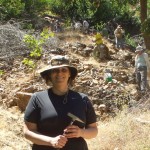
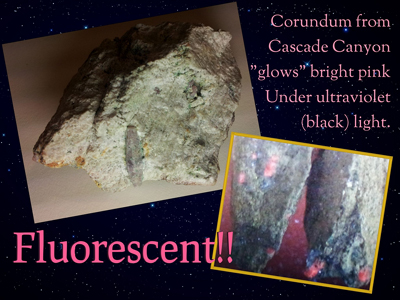
Cascade Canyon, located exactly 1.7 miles southwest of Mt. Baldy, is the home to many interesting, if small, minerals and veins of interesting polishable minerals. Collecting around the top and bottom of the canyon, we have found various qualities and sizes of corundum var. ruby along with small veins of beautiful, if hard to come by, pieces of lapis. In addition, we have found minerals that the area is not well known for, including small dravite crystals, epidote, diopside and uv reactive calcite.
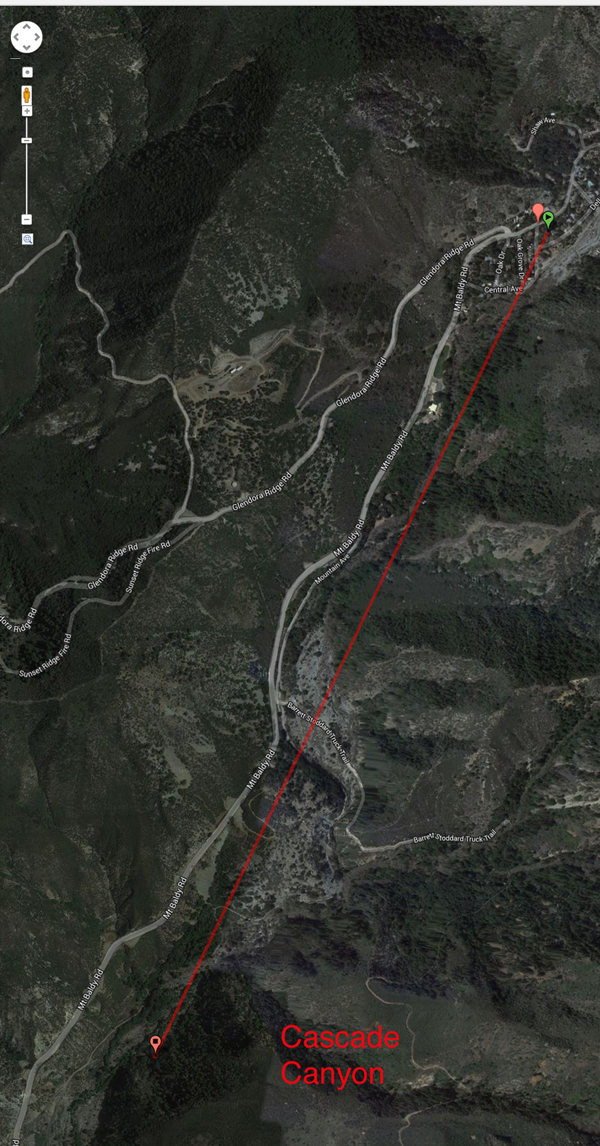
The lapis deposit is near the top of the mountain, with no access that would be considered even reasonably obtainable by anyone who is not well versed in mountain climbing. In addition, the area of the deposit was covered in an avalanche years ago. Anyone attempting to reach this deposit would be doing so at risk of life itself. In the upper streams of cascade canyon, before it turns into what would be impassible for most, bits and pieces of lapis can be found. Most people we have interviewed who have collected there in the past are happy with one visit to the location.
On Barrett-Stoddard Road, though closed to vehicle traffic, you can find interesting mineralization along the roadside, which is now a popular hiking/biking trail. Calcite veins with Diopside crystals have been located, however, the diopside is not crystallized well, with a melted appearance. The corundum locations along the roadside give the viewer a understanding that the deposit of “ruby” stretches along the entire mountainside.
Along the bottom of the canyon, on the south side of cascade canyon, along the area where the mountain follows the river on the lip of the eastern mountainside. While boulders of ruby bearing matrix can be found EVERYWHERE along the mountainside, the most popular collecting location is a small canyon that dumped out the contents of several rockslides into the valley below, creating a field rich with broken chunks of rocks with small ruby crystals inside.
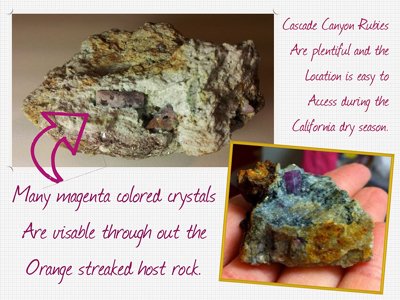
We were delighted to read Natalie Weisiger’s article about her trip to Cascade Canyon with the Gem and Mineral Council of the Los Angeles Natural History Museum. You can read about it, right here at http://omigems.com/blog/2013/07/california-corundum-from-the-ground-to-my-finger/ It is very interesting to read about the California ruby coming from the ground and into a piece of jewelry. You can certainly believe that is one unique piece of jewelry!
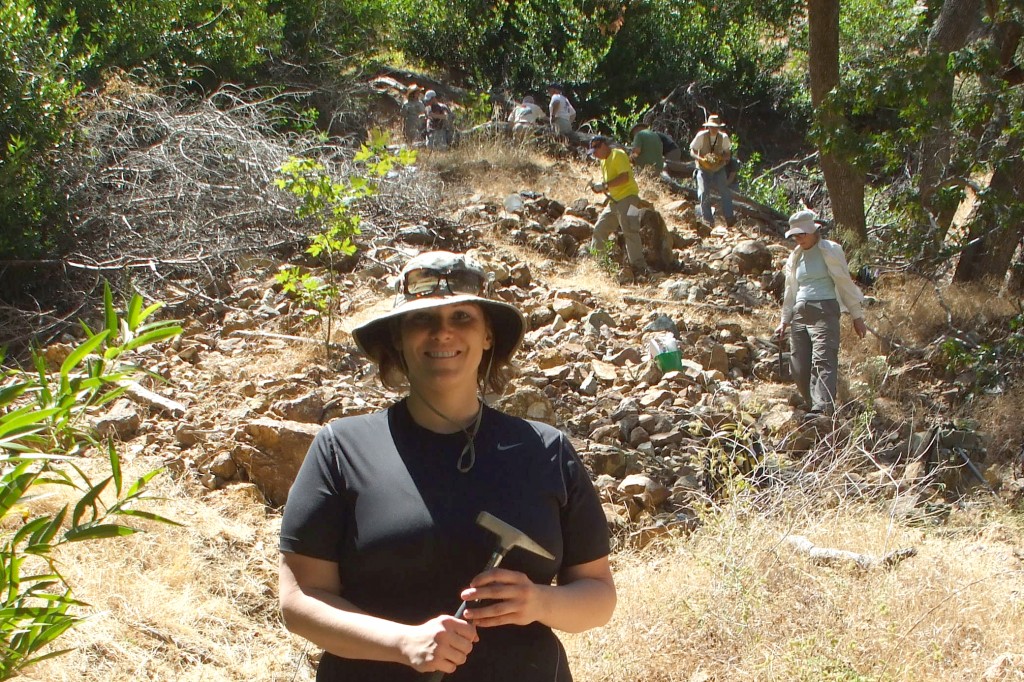
Natalie Weisiger in front of the landslide pile of ruby bearing rocks on the south side of Cascade Canyon
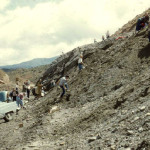
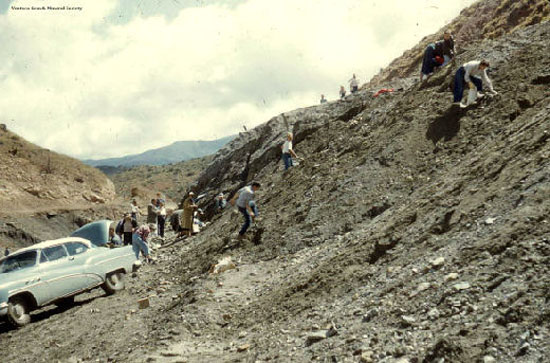
VGMS collecting at Tick Canyon back in 1957
For decades rockhounds have collected tons of howlite from the dumps of Tick Canyon.
To this day, tons of howlite still overflow at the mine dumps, dormant for over 100 years.
View Tick Canyon Howlite Collecting in a larger map
This location, clearly seen on the map above, is amazingly easy to find, park, and collect. The borate mine in Tick Canyon is called the Stearling Borax mine, which had its own mini railroad, a “dinky” sized rail, hauling borates out of the canyon to the station in Lang. The by product of colemanite mining at this location was an odd soft white material, with thin black spiderweb like inclusions running throughout. This material, Howlite, has no economic worth, as it is not an ore of borax, it is found littering the mine dumps.
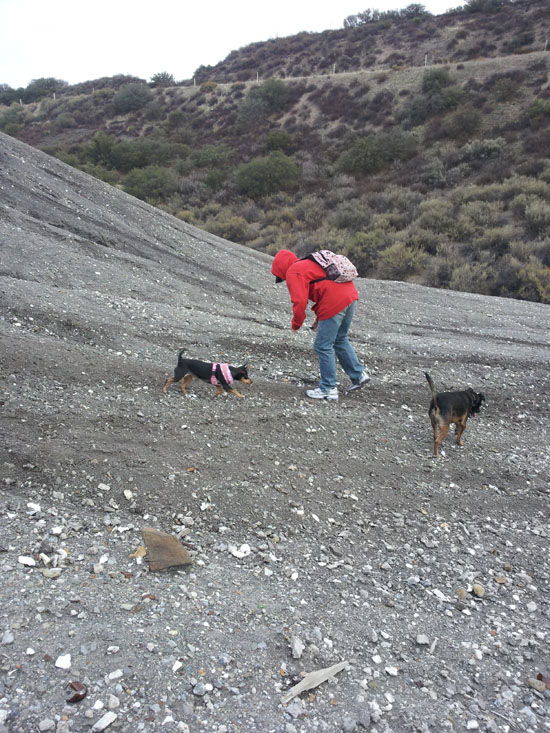
The old mining area is now fenced off with no trespassing signs. Years ago, this main area was a common field trip location for clubs from all over Southern California. Uncommon minerals like Priceite and Veatchite could be found on the dumps, along with softball sized cauliflower shaped howlite nodules. You would think that with the original mine dump off limits, collecting would be impossible.
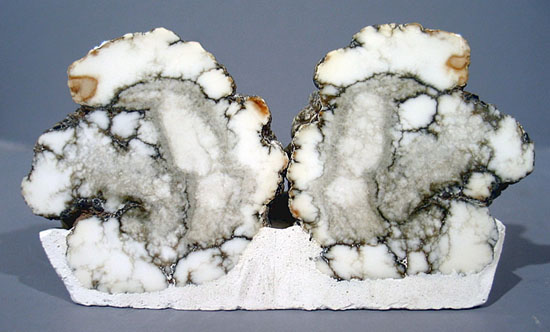
This howlite nodule was cut in half, then mounted in a block of plaster. Photo by MiddleEarthMinerals.com
Something wonderful for mineral collectors, a large amount of the dump was pushed to the other side of Davenport Road, into the canyon below. This huge dump pile is full of howlite, as we found out visiting this location on December 23rd, 2012.
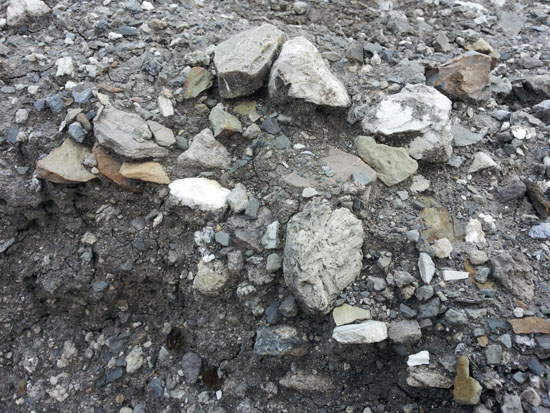
Chunks of white Howlite can be seen in the dark gray dump
Forty pounds of howlite was gathered in what seemed like no time, with no digging required. The howlite was everywhere, even down the wash dozens of feet from the main dump pile.
Howlite is soft enough to carve easily, yet hard enough to be a popular lapidary item for cabbing, tumbling, and polishing.
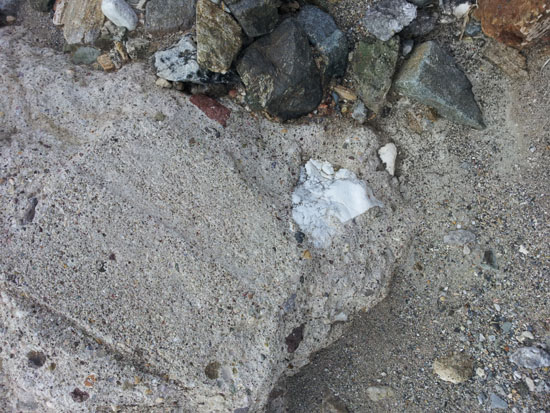
You can see that the material was so unwanted, they would use it as a filler rock in concrete.
This location is a perfect place for anyone, it is easy, interesting and filled with desirable minerals!
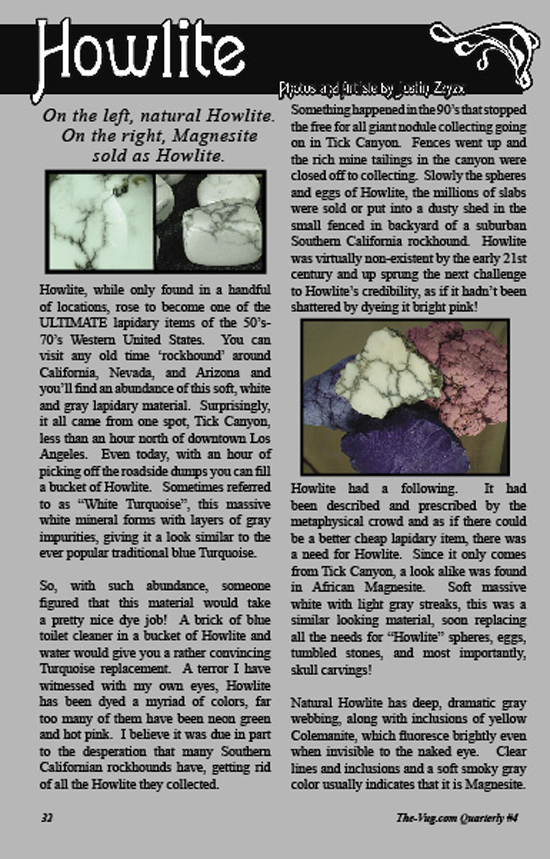
The article above is an excerpt from The-Vug.com Quarterly Magazine Fakes Issue, which was reprinted in the compilation book, available for sale directly from the publisher!
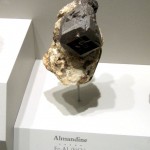
A friend of mine asked to go visit the feldspar mine on the mountain in Nuevo California, about an hour and a half outside of Los Angeles, toward Riverside and on the way to San Diego. I had not been to the location in five years and I had heard that there was a lot of activity in the area with houses being built. As this has been a classic collecting location, along with the possibility of general prospecting around the area, I wanted to see what was going on.
View Nuevo Quarry pinpointed in a larger map
First I heard there was a gate up. That did not seem to bode well, but it looks like the Korean Church at the bottom of the hill put a gate up at the beginning of the road. It was open (and public land!) so we drove through. Going up the hill was no problem, just like in the past. The odd thing was, going up the hill, the graffiti was out of control on those rocks, empty ammo cases littered the ground alongside empty beer bottles. In addition, these signs saying that the road was PRIVATE were sprayed on the boulders, which is just plain nonsense! This is a road. You can not simply buy the rights to some land and close off a public road. There were work crews, lots of construction going on and shockingly, houses were springing up in this area. The turn off to the quarry was way worse than I remember, as they graded the dirt road down, down, down, so that the turnoff was a six foot climb in the Jeep, which was a little shocking. But, then the road seemed fine, as I remember, and we pulled into the parking area to start our walk to the quarry and dump pile. Seriously, nobody is going to tell me that, as a citizen of California and America, that I am not allowed to go on a public road, to an abandoned quarry to collect some worthless rocks that nobody will miss. Just because some chumps want to spend millions of dollars to build their secluded homesites doesn’t mean they can keep me from the public road outside their house. Keep those ATVs, the gun nuts and the teenage drinkers away, I’m here for some science and some nature.
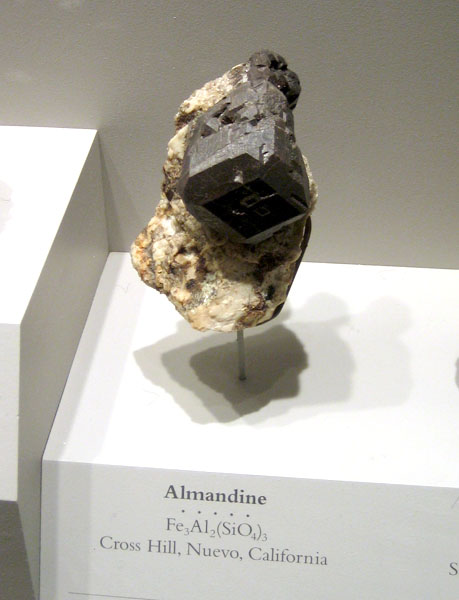
Here is the photo that got me interested again, a photo from the Smithsonian of a nice garnet from this location.
The quarry is very interesting, mainly feldspar and massive quartz, with huge crystals of schorl tourmaline embedded inside the feldspar. Along with this are garnets, most always forming in one thin layer on the outside of the feldspar blocks, the rare find of a scrap of aquamarine is possible and uncommon radioactive crystals of monazite and thorianite. I wanted to try and find some of the radioactives and nice garnet plate, my friend was looking for schorl chunks to put into reference kits for the kids. We found everything that you could expect to find from the quarry and spent about 2 hours collecting before hitting the road back to Los Angeles, with a wide open freeway, pre-rush hour, it was a great trip. If you are in the Southern California area, this is an interesting place to check out and I hope you make it without any problems and who knows, maybe in a few years the road will be paved! (and gated, to keep you ruffians out) This is BLM land, no person should DARE to stop entry to that land. Access to this area has been served by that road which far predates the church or the houses being built up there. It is absolutely shameful if anyone tries to stop you.
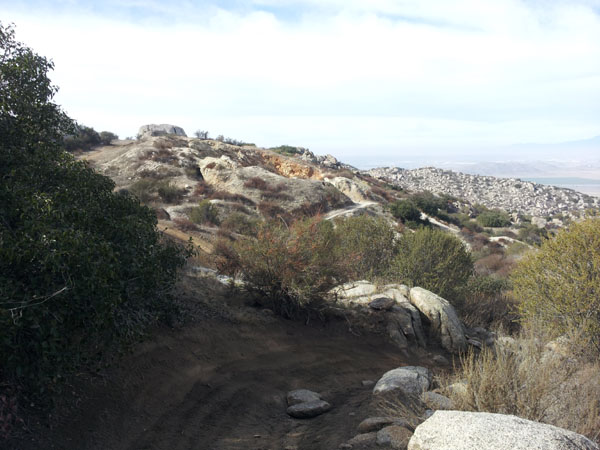
Overlooking the quarry from the parking area.
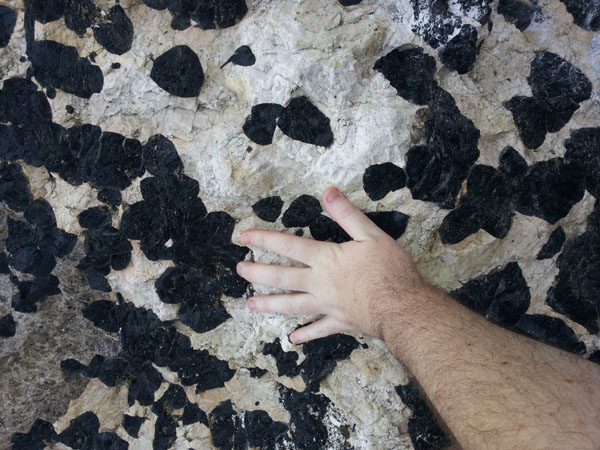
For size reference, here is my hand.
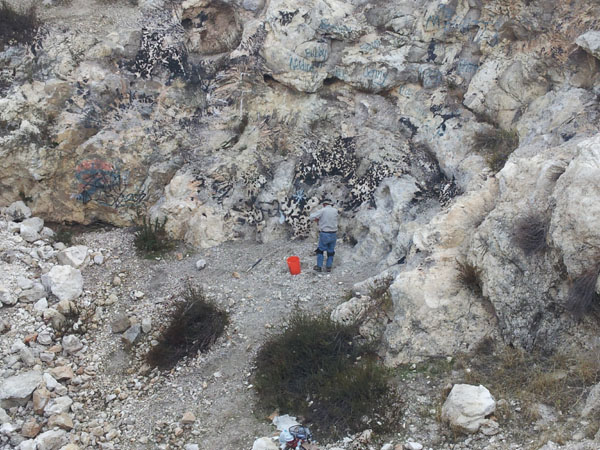
A human for size reference.
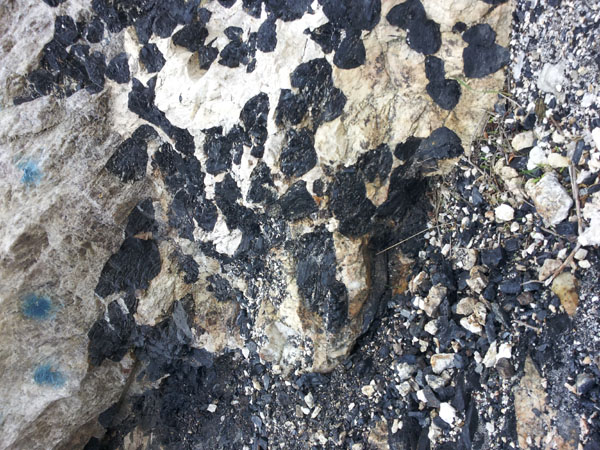
More mouth-watering schorl!
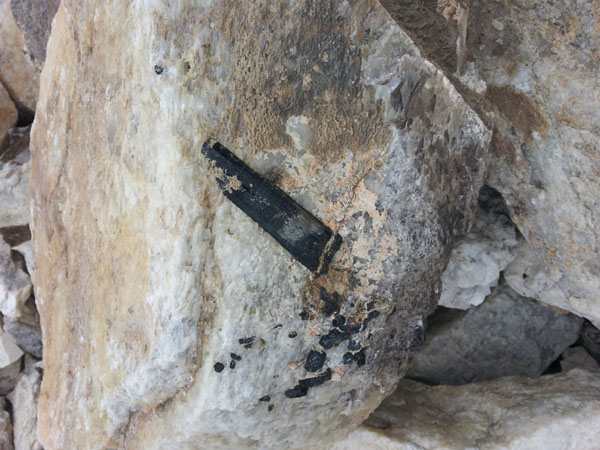
This schorl crystal would fall to bits if we tried to remove it from matrix.
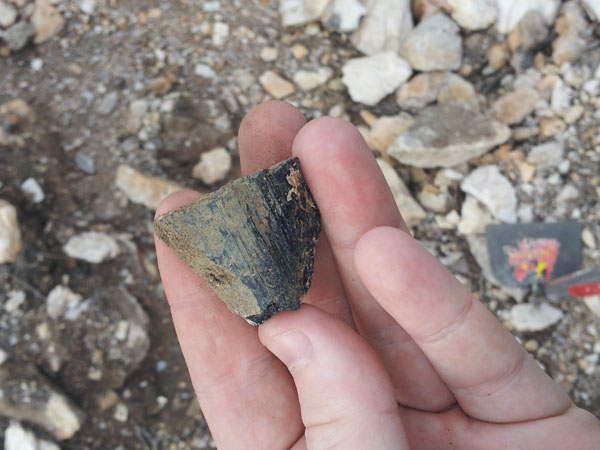
A typical scrap of Schorl Tourmaline found on the dumps.
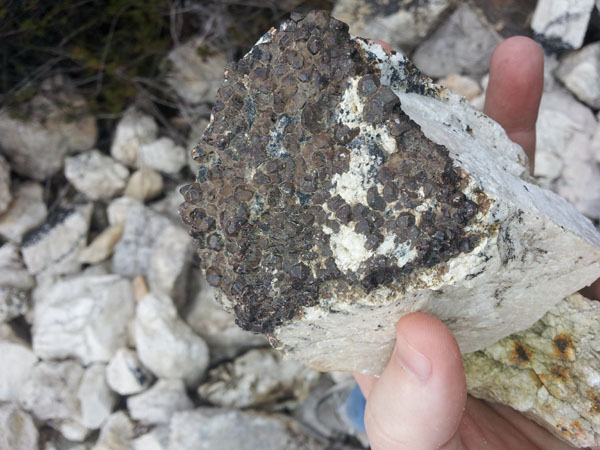
Commonly seen are the blocks of feldspar, more uncommon is a coverage as rich as this with well formed crystals.
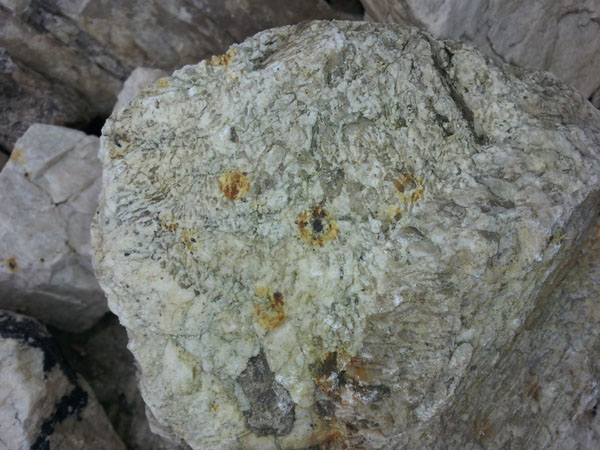
You can tell these are radioactive due to the radiation rings discoloring the quartz/feldspar matrix.
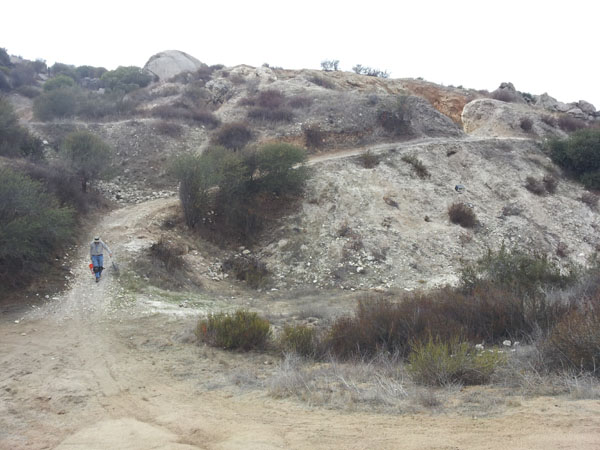
Leaving the quarry with some rocks to share with the kids.
| 